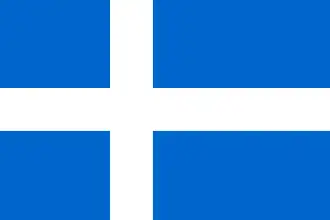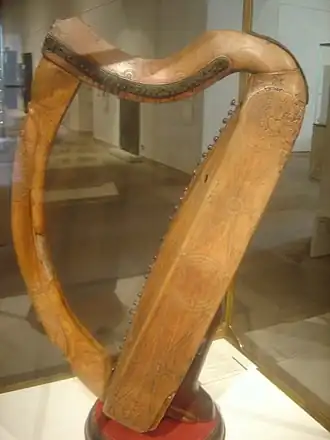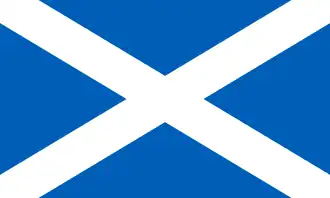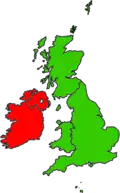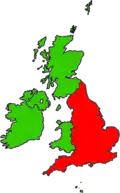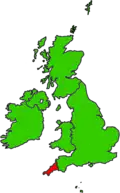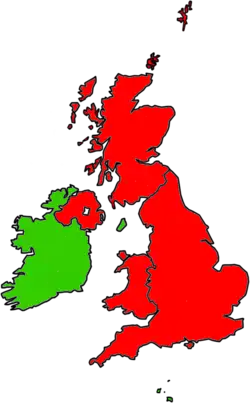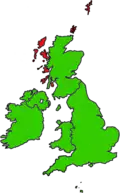Portal:Scotland/Featured
The Scotland Portal
-

 The Cuillin viewed from Applecross
The Cuillin viewed from Applecross -
![[Loch Ness]]](../_assets_/Loch_Ness%252C_Scotland_(geograph_5957043)_P-SCO_Banner.jpg)
 [Loch Ness]]
[Loch Ness]] -
| Main Page | Selected articles 1 | Selected articles 2 | Selected biographies | Selected quotes | Selected pictures | Categories & Topics |
Selection of featured articles
![]()
-
 Image 1
Image 1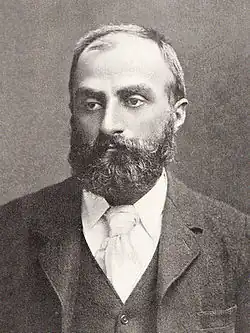
William Speirs Bruce FRSE (1 August 1867 – 28 October 1921) was a British naturalist, polar scientist and oceanographer who organised and led the Scottish National Antarctic Expedition (SNAE, 1902–04) to the South Orkney Islands and the Weddell Sea. Among other achievements, the expedition established the first permanent weather station in Antarctica. Bruce later founded the Scottish Oceanographical Laboratory in Edinburgh, but his plans for a transcontinental Antarctic march via the South Pole were abandoned because of lack of public and financial support.
In 1892 Bruce gave up his medical studies at the University of Edinburgh and joined the Dundee Whaling Expedition to Antarctica as a scientific assistant. This was followed by Arctic voyages to Novaya Zemlya, Spitsbergen and Franz Josef Land. In 1899 Bruce, by then Britain's most experienced polar scientist, applied for a post on Robert Falcon Scott's Discovery Expedition, but delays over this appointment and clashes with Royal Geographical Society (RGS) president Sir Clements Markham led him instead to organise his own expedition, and earned him the permanent enmity of the geographical establishment in London. Although Bruce received various awards for his polar work, including an honorary doctorate from the University of Aberdeen, neither he nor any of his SNAE colleagues were recommended by the RGS for the prestigious Polar Medal. (Full article...) -
![Image 2 A view of Neilston from the southwest, with the city of Glasgow in the distance Neilston (Scots: Neilstoun, Scottish Gaelic: Baile Nèill, pronounced [paləˈnɛːʎ]) is a village and parish in East Renfrewshire in the west central Lowlands of Scotland. It is in the Levern Valley, two miles (three kilometres) southwest of Barrhead, the last remaining town in greater Glasgow to have operated trams, 3+3⁄4 miles (6 kilometres) south of Paisley, and 5+3⁄4 miles (9.5 kilometres) south-southwest of Renfrew, at the southwestern fringe of the Greater Glasgow conurbation. Neilston is a dormitory village with a resident population of just over 5,000 people. Neilston is mentioned in documents from the 12th century, when the feudal lord Robert de Croc, endowed a chapel to Paisley Abbey to the North. Neilston Parish Church—a Category B listed building—is said to be on the site of this original chapel and has been at the centre of the community since 1163. Little remains of the original structure. Before industrialisation, Neilston was a scattered farming settlement composed of a series of single-storey houses, many of them thatched. Some domestic weaving was carried out using local flax. Water power from nearby streams ground corn and provided a suitable environment for bleaching the flax. (Full article...)](../_assets_/Blank.png) Image 2
Image 2 A view of Neilston from the southwest, with the city of Glasgow in the distance
A view of Neilston from the southwest, with the city of Glasgow in the distance
Neilston (Scots: Neilstoun, Scottish Gaelic: Baile Nèill, pronounced [paləˈnɛːʎ]) is a village and parish in East Renfrewshire in the west central Lowlands of Scotland. It is in the Levern Valley, two miles (three kilometres) southwest of Barrhead, the last remaining town in greater Glasgow to have operated
trams, 3+3⁄4 miles (6 kilometres) south of Paisley, and 5+3⁄4 miles (9.5 kilometres) south-southwest of Renfrew, at the southwestern fringe of the Greater Glasgow conurbation. Neilston is a dormitory village with a resident population of just over 5,000 people.
Neilston is mentioned in documents from the 12th century, when the feudal lord Robert de Croc, endowed a chapel to Paisley Abbey to the North. Neilston Parish Church—a Category B listed building—is said to be on the site of this original chapel and has been at the centre of the community since 1163. Little remains of the original structure. Before industrialisation, Neilston was a scattered farming settlement composed of a series of single-storey houses, many of them thatched. Some domestic weaving was carried out using local flax. Water power from nearby streams ground corn and provided a suitable environment for bleaching the flax. (Full article...) -
 Image 3
Image 3 Ramillies at anchor during the First World War, painted in dazzle camouflage
Ramillies at anchor during the First World War, painted in dazzle camouflage
HMS Ramillies (pennant number: 07) was one of five Revenge-class battleships built for the Royal Navy during the First World War. They were developments of the Queen Elizabeth-class battleships, with reductions in size and speed to offset increases in the armour protection whilst retaining the same main battery of eight 15-inch (381 mm) guns. Completed in late 1917, Ramillies saw no combat during the war as both the British and the German fleets had adopted a more cautious strategy by this time owing to the increasing threat of naval mines and submarines.
Ramillies spent the 1920s and 1930s alternating between the Atlantic Fleet and the Mediterranean Fleet. Whilst serving in the Mediterranean and Black Seas in the early 1920s, the ship went to Turkey twice in response to crises arising from the Greco-Turkish War, including the Great Fire of Smyrna in 1922. She also saw limited involvement during the Allied intervention in the Russian Civil War. The ship's interwar career was otherwise uneventful. With the outbreak of the Second World War in September 1939, Ramillies was initially assigned to escort duties in the North Atlantic. In May 1940, she was transferred to the Mediterranean Fleet as war with Italy loomed. After the Italians entered the war in June, Ramillies bombarded Italian ports in North Africa, escorted convoys to Malta, and supported the Taranto raid in November. (Full article...) -
 Image 4
Image 4-p162-Nuckalavee-illustr-J_Torrance_(cropped).jpg)
The nuckelavee chasing an islander, painting by James Torrance (1859–1916).
The nuckelavee ( /nʌklɑːˈviː/) or nuckalavee is a horse-like demon from Orcadian folklore that combines equine and human elements. It resembles a fleshless human head, torso, and arms longer than normal coming out of a fleshless horse's back at the point where a horse rider would usually sit as the horse body also sports one eye and fins on its legs. British folklorist Katharine Briggs called it "the nastiest" of all the demons of Scotland's Northern Isles. The nuckelavee's breath was thought to wilt crops and sicken livestock and the creature was held responsible for droughts and epidemics on land despite being predominantly a sea-dweller.
A graphic description of the nuckelavee as it appears on land was given by an islander who claimed to have had a confrontation with it, but accounts describing the details of the creature's appearance are inconsistent. In common with many other sea monsters, it is unable to tolerate fresh water. Therefore, those it is pursuing have only to cross a river or stream to be rid of it. The nuckelavee is kept in confinement during the summer months by the Mither o' the Sea, an ancient Orcadian spirit, and the only one able to control it. (Full article...) -
 Image 5
Image 5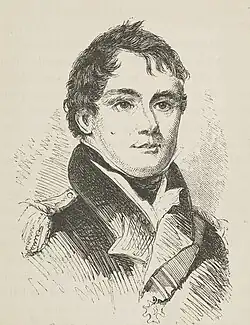 1817 portrait of Maxwell
1817 portrait of Maxwell
Captain Sir Murray Maxwell, CB, FRS (10 September 1775 – 26 June 1831) was a Royal Navy officer who served in the French Revolutionary and Napoleonic Wars. Maxwell first gained recognition in the British navy during the successful Adriatic campaign of 1807–1814, during which he destroyed a French supply convoy during the action of 29 November 1811. As a result of achieving further victories in the Mediterranean, Maxwell was given increasingly important positions and, despite losing the frigate HMS Daedalus off British Ceylon in 1813, was appointed to escort ambassador Lord Amherst to China in 1816.
The voyage to China went awry when Maxwell's ship HMS Alceste wrecked in the Gaspar Strait, and he and his crew became stranded on a nearby island. The shipwrecked crew of Alceste ran low on supplies and were repeatedly attacked by Malay pirates, but thanks to Maxwell's leadership suffered no deaths. Eventually rescued by a brig of the East India Company, the party returned to Britain as heroes, with Maxwell being especially commended. He was knighted for his services, and made a brief and unsuccessful foray into politics before resuming his naval career. In 1831 Maxwell was appointed the Lieutenant Governor of Prince Edward Island, but fell ill and died before he could take up the post. (Full article...) -
 Image 6
Image 6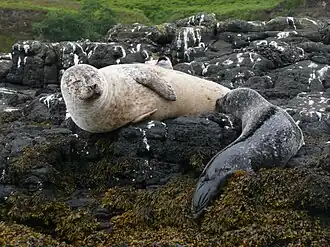
A grey seal (Halichoerus grypus) feeding a pup, island of Skye.
The fauna of Scotland is generally typical of the northwest European part of the Palearctic realm, although several of the country's larger mammals were hunted to extinction in historic times and human activity has also led to various species of wildlife being introduced. Scotland's diverse temperate environments support 62 species of wild mammals, including a population of wildcats, important numbers of grey and harbour seals and the most northerly colony of bottlenose dolphins in the world.
Many populations of moorland birds, including the black and red grouse, live here, and the country has internationally significant nesting grounds for seabirds such as the northern gannet. The golden eagle has become a national icon, and white-tailed eagles and ospreys have recently re-colonised the land. The Scottish crossbill is the only endemic vertebrate species in the UK. (Full article...) -
 Image 7
Image 7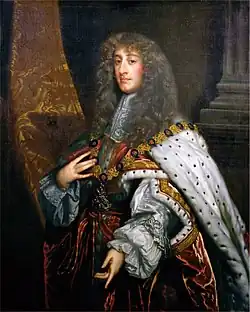 Portrait by Peter Lely
Portrait by Peter Lely
James II and VII (14 October 1633 O.S. – 16 September 1701) was King of England and Ireland as James II and King of Scotland as James VII from the death of his elder brother, Charles II, on 6 February 1685, until he was deposed in the 1688 Glorious Revolution. The last Catholic monarch of England, Scotland, and Ireland, his reign is now remembered primarily for conflicts over religion. However, it also involved struggles over the principles of absolutism and divine right of kings, with his deposition ending a century of political and civil strife by confirming the primacy of the English Parliament over the Crown.
James was the second surviving son of Charles I of England and Henrietta Maria of France, and was created Duke of York at birth. He succeeded to the throne aged 51 with widespread support. The general public were reluctant to undermine the principle of hereditary succession after the trauma of the brief republican Commonwealth of England 25 years before, and believed that a Catholic monarchy was purely temporary. However, tolerance of James's personal views did not extend to Catholicism in general, and both the English and Scottish parliaments refused to pass measures viewed as undermining the primacy of the Protestant religion. His attempts to impose them by absolutist decrees as a matter of his perceived divine right met with opposition. (Full article...) -
 Image 8
Image 8
Mary, Queen of Scots (8 December 1542 – 8 February 1587), also known as Mary Stuart or Mary I of Scotland, was Queen of Scotland from 14 December 1542 until her forced abdication on 24 July 1567.
The only surviving legitimate child of James V of Scotland, Mary was six days old when her father died and she inherited the throne. During her childhood, Scotland was governed by regents, first by the heir to the throne, James Hamilton, Earl of Arran, and then by her mother, Mary of Guise. In 1548, she was betrothed to Francis, the Dauphin of France, and was sent to be brought up in France, where she would be safe from invading English forces during the Rough Wooing. Mary married Francis in 1558, becoming queen consort of France from his accession in 1559 until his death in December 1560. Widowed, Mary returned to Scotland in August 1561. The tense religious and political climate following the Scottish Reformation that Mary encountered on her return to Scotland was further agitated by prominent Scots such as John Knox, who openly questioned whether her subjects had a duty to obey her. The early years of her personal rule were marked by pragmatism, tolerance, and moderation. She issued a proclamation accepting the religious settlement in Scotland as she had found it upon her return, retained advisers such as James Stewart, Earl of Moray (her illegitimate half-brother), and William Maitland of Lethington, and governed as the Catholic monarch of a Protestant kingdom. (Full article...) -
 Image 9
Image 9 Sir Hector MacLean's charge at Inverkeithing (1873 illustration)
Sir Hector MacLean's charge at Inverkeithing (1873 illustration)
The Battle of Inverkeithing was fought on 20 July 1651 between an English army under John Lambert and a Scottish army led by James Holborne as part of an English invasion of Scotland. The battle was fought near the isthmus of the Ferry Peninsula, to the south of Inverkeithing, after which it is named.
An English Parliamentary regime had tried, convicted, and executed Charles I, who was king of both Scotland and England in a personal union, in January 1649. The Scots recognised his son, also named Charles, as king of Britain and set about recruiting an army. An English army, under Oliver Cromwell, invaded Scotland in July 1650. The Scottish army, commanded by David Leslie, refused battle until 3 September when it was heavily defeated at the Battle of Dunbar. The English occupied Edinburgh and the Scots withdrew to the choke point of Stirling. For nearly a year all attempts to storm or bypass Stirling, or to draw the Scots out into another battle, failed. On 17 July 1651 1,600 English soldiers crossed the Firth of Forth at its narrowest point in specially constructed flat-bottomed boats and landed at North Queensferry on the Ferry Peninsula. The Scots sent forces to pen the English in and the English reinforced their landing. On 20 July the Scots moved against the English and in a short engagement were routed. (Full article...) -
 Image 10
Image 10 Insignia of Knights and Ladies of the Most Ancient and Most Noble Order of the Thistle
Insignia of Knights and Ladies of the Most Ancient and Most Noble Order of the Thistle
The Most Ancient and Most Noble Order of the Thistle is an order of chivalry associated with Scotland. The current version of the order was founded in 1687 by King James VII of Scotland, who asserted that he was reviving an earlier order. The order consists of the sovereign and sixteen knights and ladies, as well as certain "extra" knights (members of the British royal family and foreign monarchs). The sovereign alone grants membership of the order; they are not advised by the government, as occurs with most other orders.
The order's primary emblem is the thistle, the national flower of Scotland. The motto is Nemo me impune lacessit (Latin for "No one provokes me with impunity"). The same motto appears on the Royal coat of arms of the United Kingdom for use in Scotland and pound coins minted in 1984, 1989, 1994, and 1999 (since withdrawn), and is also the motto of the Royal Scots Dragoon Guards, the Scots Guards, the Royal Regiment of Scotland, and the Black Watch (Royal Highland Regiment) of Canada. The patron saint of the order is St Andrew. (Full article...) -
 Image 11
Image 11
The War of the League of Cambrai, also known by its second stage as the War of the Holy League, was fought from December 1508 to December 1516, as part of the wider Italian Wars of 1494–1559. The main participants of the war, who fought for its entire duration, were France, the Holy Roman Empire, the Papal States, and the Republic of Venice; they were joined at various times by nearly every significant power in Western Europe, including Spain, England, the Duchy of Milan, the Republic of Florence, the Duchy of Ferrara, and the Swiss.
The war was preceded by the Italienzug of Maximilian I, King of the Romans, who crossed into Venetian territory in February 1508 with the imperial army on the way to be crowned Holy Roman Emperor by the pope in Rome. Meanwhile, Pope Julius II, intending to curb Venetian influence in northern Italy, brought together the League of Cambrai, an anti-Venetian alliance consisting of him, Maximilian I, Louis XII of France, and Ferdinand II of Aragon, which was formally concluded in December 1508. Although the League was initially successful, later frictions between Julius and Louis culminated in the pope abandoning the League in 1510 and allying himself with Venice against France. (Full article...) -
 Image 12The Second War of Scottish Independence broke out in 1332, when Edward Balliol led an English-backed invasion of Scotland. Balliol, the son of former Scottish king John Balliol, was attempting to make good his claim to the Scottish throne. He was opposed by Scots loyal to the occupant of the throne, eight-year-old David II. At the Battle of Dupplin Moor Balliol's force defeated a Scottish army ten times their size and Balliol was crowned king. Within three months David's partisans had regrouped and forced Balliol out of Scotland. He appealed to the English king, Edward III, who invaded Scotland in 1333 and besieged the important trading town of Berwick. A large Scottish army attempted to relieve it but was heavily defeated at the Battle of Halidon Hill. Balliol established his authority over most of Scotland, ceded to England the eight counties of south-east Scotland and did homage to Edward for the rest of the country as a fief.
Image 12The Second War of Scottish Independence broke out in 1332, when Edward Balliol led an English-backed invasion of Scotland. Balliol, the son of former Scottish king John Balliol, was attempting to make good his claim to the Scottish throne. He was opposed by Scots loyal to the occupant of the throne, eight-year-old David II. At the Battle of Dupplin Moor Balliol's force defeated a Scottish army ten times their size and Balliol was crowned king. Within three months David's partisans had regrouped and forced Balliol out of Scotland. He appealed to the English king, Edward III, who invaded Scotland in 1333 and besieged the important trading town of Berwick. A large Scottish army attempted to relieve it but was heavily defeated at the Battle of Halidon Hill. Balliol established his authority over most of Scotland, ceded to England the eight counties of south-east Scotland and did homage to Edward for the rest of the country as a fief.
As allies of Scotland via the Auld Alliance, the French were unhappy about an English expansion into Scotland and so covertly supported and financed David's loyalists. Balliol's allies fell out among themselves and he lost control of most of Scotland again by late 1334. In early 1335, the French attempted to broker a peace. However, the Scots were unable to agree on a position and Edward prevaricated while building a large army. He invaded in July and again overran most of Scotland. Tensions with France increased. Further French-sponsored peace talks failed in 1336; in May 1337, King Philip VI of France engineered a clear break between France and England, starting the Hundred Years' War. The Anglo-Scottish war became a subsidiary theatre of this larger Anglo-French war. Edward sent what troops he could spare to Scotland, in spite of which the English slowly lost ground in Scotland as they were forced to focus on the French theatre. Achieving his majority, David returned to Scotland from France in 1341; by 1342, the English had been cleared from north of the border. (Full article...) -
 Image 13
Image 13%252C_by_Peter_Lely.jpg) Portrait by Peter Lely, 1648–49
Portrait by Peter Lely, 1648–49
Elizabeth Maitland, Duchess of Lauderdale (née Murray; 28 September 1626 – 5 June 1698) was a Scottish peeress. She was the eldest daughter of William Murray and his wife Catherine, the Earl and Countess of Dysart. She was raised in English court circles during the years leading up to the English Civil War and received a well-rounded education from her parents. Her first husband was Lionel Tollemache, with whom she had eleven children. In 1672, three years after Lionel's death, she married John Maitland and gained a prominent position in the restored court.
After her father's death, Maitland held the title of Countess of Dysart in her own right. After her remarriage in 1672, she was also the Duchess of Lauderdale. She was famous for the political influence she exercised and for her support for Charles II during his exile. As an associate of the secret Royalist organisation known as the Sealed Knot, she actively supported the return of the monarchy after the execution of Charles I. She was also a lifelong patron of artists, particularly Peter Lely. She died at the age of 71 at her family home, Ham House near Richmond by the Thames, and is buried in the nearby parish church. (Full article...) -
 Image 14
Image 14_crop.jpg) Argus in harbour in 1918, painted in dazzle camouflage
Argus in harbour in 1918, painted in dazzle camouflage
HMS Argus was a British aircraft carrier that served in the Royal Navy from 1918 to 1944. She was converted from an ocean liner that was under construction when the First World War began and became the first aircraft carrier with a full-length flight deck that allowed wheeled aircraft to take off and land. After commissioning, the ship was involved for several years in the development of the optimum design for other aircraft carriers. Argus also evaluated various types of arresting gear, general procedures needed to operate a number of aircraft in concert and fleet tactics. The ship was too top-heavy as originally built, and had to be modified to improve her stability in the mid-1920s. She spent one brief deployment on the China Station in the late 1920s before being placed in reserve for budgetary reasons.
Argus was recommissioned and partially modernised shortly before the Second World War and served as a training ship for deck-landing practice until June 1940. The following month she made the first of her many ferry trips to the Western Mediterranean to fly off fighters to Malta; she was largely occupied in this task for the next two years. The ship also delivered aircraft to Murmansk, Russia, Takoradi in the Gold Coast, and Reykjavík, Iceland. By 1942, the Royal Navy was very short of aircraft carriers, and Argus was pressed into front-line service despite her lack of speed and armament. In June, she participated in Operation Harpoon, providing air cover for the Malta-bound convoy. In November, the ship provided air cover during Operation Torch, the invasion of French North Africa, and was slightly damaged by a bomb. After returning to the UK for repairs, Argus was used again for deck-landing practice until late September 1944. In December, she became an accommodation ship, and was listed for disposal in mid-1946. The ship was sold in late 1946 and scrapped the following year. (Full article...) -
 Image 15
Image 15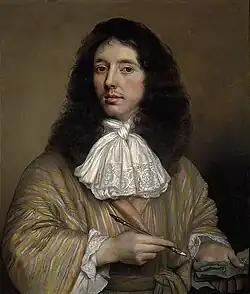 Painting of Bruce by John Michael Wright, c. 1664
Painting of Bruce by John Michael Wright, c. 1664
Sir William Bruce of Kinross, 1st Baronet (c. 1630 – 1710), was a Scottish gentleman-architect, "the effective founder of classical architecture in Scotland," as Howard Colvin observes. As a key figure in introducing the Palladian style into Scotland, he has been compared to the pioneering English architects Inigo Jones and Christopher Wren, and to the contemporaneous introducers of French style in English domestic architecture, Hugh May and Sir Roger Pratt.
Bruce was a merchant in Rotterdam during the 1650s, and played a role in the Restoration of Charles II in 1659. He carried messages between the exiled king and General Monck, and his loyalty to the king was rewarded with lucrative official appointments, including that of Surveyor General of the King's Works in Scotland, effectively making Bruce the "king's architect". His patrons included John Maitland, 1st Duke of Lauderdale, the most powerful man in Scotland at that time, and Bruce rose to become a member of Parliament, and briefly sat on the Privy Council of Scotland. (Full article...) -
![Image 16 Satellite image of northern Britain and Ireland showing the approximate area of Dál Riata (shaded) Áedán mac Gabráin (Old Irish pronunciation: [ˈaiðaːn mak ˈɡaβraːnʲ]; Irish: Aodhán mac Gabhráin), also written as Aedan, was a king of Dál Riata from c. 574 until c. 609 AD. The kingdom of Dál Riata was situated in modern Argyll and Bute, Scotland, and parts of County Antrim, Ireland. Genealogies record that Áedán was a son of Gabrán mac Domangairt. He was a contemporary of Saint Columba, and much that is recorded of his life and career comes from hagiography such as Adomnán of Iona's Life of Saint Columba. Áedán appears as a character in Old Irish and Middle Irish language works of prose and verse, some now lost. (Full article...)](../_assets_/Blank.png) Image 16
Image 16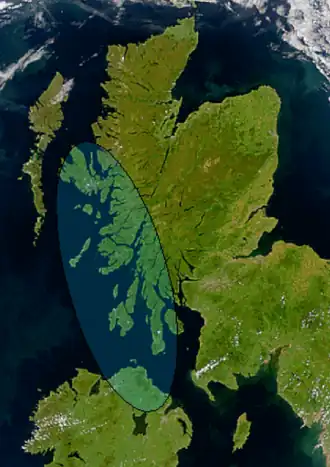
Satellite image of northern Britain and Ireland showing the approximate area of Dál Riata (shaded)
Áedán mac Gabráin (Old Irish pronunciation: [ˈaiðaːn mak ˈɡaβraːnʲ]; Irish: Aodhán mac Gabhráin), also written as Aedan, was a king of Dál Riata from c. 574 until c. 609 AD. The kingdom of Dál Riata was situated in modern Argyll and Bute, Scotland, and parts of County Antrim, Ireland. Genealogies record that Áedán was a son of Gabrán mac Domangairt.
He was a contemporary of Saint Columba, and much that is recorded of his life and career comes from hagiography such as Adomnán of Iona's Life of Saint Columba. Áedán appears as a character in Old Irish and Middle Irish language works of prose and verse, some now lost. (Full article...) -
 Image 17
Image 17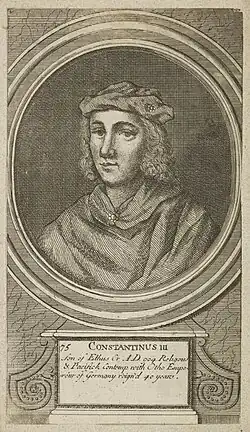 Fictional 17th-century drawing
Fictional 17th-century drawing
Causantín mac Áeda (Modern Gaelic: Còiseam mac Aoidh, anglicised Constantine II; born no later than 879; died 952) was an early King of Scotland, known then by the Gaelic name Alba. The Kingdom of Alba, a name which first appears in Constantine's lifetime, was situated in what is now Northern Scotland.
The core of the kingdom was formed by the lands around the River Tay. Its southern limit was the River Forth, northwards it extended towards the Moray Firth and perhaps to Caithness, while its western limits are uncertain. Constantine's grandfather Kenneth I (Cináed mac Ailpín, died 858) was the first of the family recorded as a king, but as king of the Picts. This change of title, from king of the Picts to king of Alba, is part of a broader transformation of Pictland and the origins of the Kingdom of Alba are traced to Constantine's lifetime. (Full article...) -
![Image 18 Duke of Marlborough Signing the Despatch at Blenheim The Battle of Blenheim (German: Zweite Schlacht bei Höchstädt; French: Bataille de Höchstädt; Dutch: Slag bij Blenheim) fought on 13 August [O.S. 2 August] 1704, was a major battle of the War of the Spanish Succession. The overwhelming Allied victory ensured the safety of Vienna from the Franco-Bavarian army, thus preventing the collapse of the reconstituted Grand Alliance. Louis XIV of France sought to knock the Holy Roman Emperor, Leopold, out of the war by seizing Vienna, the Habsburg capital, and gain a favourable peace settlement. The dangers to Vienna were considerable: Maximilian II Emanuel, Elector of Bavaria, and Marshal Ferdinand de Marsin's forces in Bavaria threatened from the west, and Marshal Louis Joseph de Bourbon, duc de Vendôme's large army in northern Italy posed a serious danger with a potential offensive through the Brenner Pass. Vienna was also under pressure from Rákóczi's Hungarian revolt from its eastern approaches. Realising the danger, the Duke of Marlborough resolved to alleviate the peril to Vienna by marching his forces south from Bedburg to help maintain Emperor Leopold within the Grand Alliance. (Full article...)](../_assets_/Blank.png) Image 18
Image 18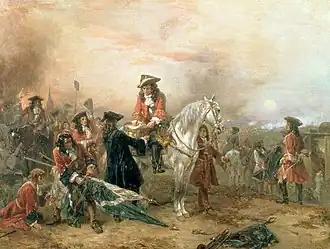 Duke of Marlborough Signing the Despatch at Blenheim
Duke of Marlborough Signing the Despatch at Blenheim
The Battle of Blenheim (German: Zweite Schlacht bei Höchstädt; French: Bataille de Höchstädt; Dutch: Slag bij Blenheim) fought on 13 August [O.S. 2 August] 1704, was a major battle of the War of the Spanish Succession. The overwhelming Allied victory ensured the safety of Vienna from the Franco-Bavarian army, thus preventing the collapse of the reconstituted Grand Alliance.
Louis XIV of France sought to knock the Holy Roman Emperor, Leopold, out of the war by seizing Vienna, the Habsburg capital, and gain a favourable peace settlement. The dangers to Vienna were considerable: Maximilian II Emanuel, Elector of Bavaria, and Marshal Ferdinand de Marsin's forces in Bavaria threatened from the west, and Marshal Louis Joseph de Bourbon, duc de Vendôme's large army in northern Italy posed a serious danger with a potential offensive through the Brenner Pass. Vienna was also under pressure from Rákóczi's Hungarian revolt from its eastern approaches. Realising the danger, the Duke of Marlborough resolved to alleviate the peril to Vienna by marching his forces south from Bedburg to help maintain Emperor Leopold within the Grand Alliance. (Full article...) -
 Image 19
Image 19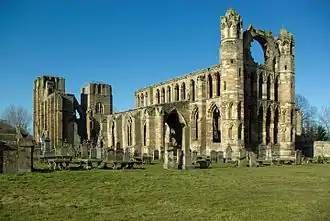
Elgin Cathedral, a historic ruin in Elgin, Moray, northeast Scotland, was dedicated to the Holy Trinity. It was established in 1224 on land granted by King Alexander II and stood outside the burgh of Elgin, close to the River Lossie. It replaced the cathedral at Spynie located 3 kilometres (2 mi) to the north, which was served by a small chapter of eight clerics. By 1226, the new and developing cathedral was staffed with 18 canons, a number that increased to 23 by 1242. A damaging fire in 1270 led to significant enlargement. It remained unscathed during the Wars of Scottish Independence but suffered extensive fire damage in 1390 when attacked by Robert III's brother Alexander Stewart, Earl of Buchan, also known as the Wolf of Badenoch. In 1402, the cathedral precinct faced another incendiary attack by the Lord of the Isles followers.
As the cathedral grew, so did the number of clerics and craftsmen. Repairs following the fires of 1270 and 1390 resulted in the choir's doubling in length and the addition of outer aisles to both the nave and choir. While some parts of walls retain their full height, others are at foundation level, yet the overall cruciform shape is still discernible. A mostly intact octagonal chapter house dates from the major enlargement after the fire of 1270. The near intact gable wall above the double door entrance linking the west towers was rebuilt after the fire of 1390. It contains fragments of a large rose window with remnants of tracery work. The transepts and the south aisle of the choir contain recessed and chest tombs with effigies of bishops and knights. The now grass-covered floor bears large flat slabs marking early graves. The residences of the dignitaries, canons and chaplains within the chanonry were also destroyed during the fires of 1270, 1390 and 1402, forming part of the overall reconstruction process. Only the precentor's manse remains substantially intact, while two others have been incorporated into private buildings. Both west front towers, part of the initial construction, are mostly complete. A massive protective wall surrounded the cathedral precinct, but only two small sections have survived. Of the wall's four access gates, only the Pans Port remains. (Full article...) -
 Image 20
Image 20
Rockstar North (Rockstar Games UK Limited; formerly DMA Design Limited) is a British video game developer and a studio of Rockstar Games based in Edinburgh. The studio is best known for creating the Lemmings and Grand Theft Auto series, including Grand Theft Auto V, the second-best-selling game and most profitable entertainment product of all time.
David Jones founded the company as DMA Design in 1988 in his hometown of Dundee. During his studies, he had developed the game Menace and struck a six-game publishing deal with Psygnosis, which released Jones's project in October 1988. While making its sequel, Blood Money, Jones dropped out, hired several of his friends, including Mike Dailly, Steve Hammond, and Russell Kay, with whom he had attended the Kingsway Amateur Computer Club. They opened the company's first offices above a former fish and chip shop in 1989. Following the successful 1991 release of Lemmings, the studio rapidly expanded and moved into proper offices, after which Kay left to establish Visual Sciences. Several Lemmings expansions and sequels later, 1994's All New World of Lemmings was DMA Design's final game in the series and its last with Psygnosis. (Full article...) -
 Image 21
Image 21Dunnottar Castle in the Mearns occupies one of the best defensive locations in Great Britain. The site was in use throughout the High Middle Ages, and the castle itself dates to the fourteenth century.
The High Middle Ages of Scotland encompass Scotland in the era between the death of Domnall II in 900 AD and the death of King Alexander III in 1286, which was an indirect cause of the Wars of Scottish Independence.
At the close of the ninth century, various competing kingdoms occupied the territory of modern Scotland. Scandinavian influence was dominant in the northern and western islands, Brythonic culture in the southwest, the Anglo-Saxon or English Kingdom of Northumbria in the southeast and the Pictish and Gaelic Kingdom of Alba in the east, north of the River Forth. By the tenth and eleventh centuries, northern Great Britain was increasingly dominated by Gaelic culture, and by the Gaelic regal lordship of Alba, known in Latin as either Albania or Scotia, and in English as "Scotland". From its base in the east, this kingdom acquired control of the lands lying to the south and ultimately the west and much of the north. It had a flourishing culture, comprising part of the larger Gaelic-speaking world and an economy dominated by agriculture and trade. (Full article...) -
 Image 22
Image 22 1920 map of the railway
1920 map of the railway
The Great North of Scotland Railway (GNSR) was one of the two smallest of the five major Scottish railway companies prior to the 1923 Grouping, operating in the north-east of the country. Formed in 1845, it carried its first passengers the 39 miles (63 km) from Kittybrewster, in Aberdeen, to Huntly on 20 September 1854. By 1867 it owned 226+1⁄4 route miles (364.1 km) of line and operated over a further 61 miles (98 km).
The early expansion was followed by a period of forced economy, but in the 1880s the railway was refurbished, express services began to run and by the end of that decade there was a suburban service in Aberdeen. The railway operated its main line between Aberdeen and Keith and two routes west to Elgin, connections could be made at both Keith and Elgin for Highland Railway services to Inverness. There were other junctions with the Highland Railway at Boat of Garten and Portessie, and at Aberdeen connections for journeys south over the Caledonian and North British Railways. Its eventual area encompassed the three Scottish counties of Aberdeenshire, Banffshire and Moray, with short lengths of line in Inverness-shire and Kincardineshire. (Full article...) -
 Image 23"From the Doctor to My Son Thomas" is a viral video recorded by actor Peter Capaldi and sent to Thomas Goodall, an autistic nine-year-old boy in England, to console the child over grief from the death of Goodall's grandmother. Capaldi filmed the 42-second video in character as the Twelfth Doctor from the BBC science-fiction series Doctor Who. Capaldi's message had a positive effect on Thomas: he smiled for the first time since learning of his grandmother's death, and gained the courage to go to her funeral.
Image 23"From the Doctor to My Son Thomas" is a viral video recorded by actor Peter Capaldi and sent to Thomas Goodall, an autistic nine-year-old boy in England, to console the child over grief from the death of Goodall's grandmother. Capaldi filmed the 42-second video in character as the Twelfth Doctor from the BBC science-fiction series Doctor Who. Capaldi's message had a positive effect on Thomas: he smiled for the first time since learning of his grandmother's death, and gained the courage to go to her funeral.
Thomas's father Ross Goodall posted the video to YouTube on 6 November 2014, wanting to make the video available to his family, but had no idea it would become popular online. The video was viewed over 200,000 times in its first 48 hours online, and more than doubled the next day, and less than a week later it had over 900,000 total views, making it a viral video, with the responses becoming a global phenomenon. (Full article...) -
 Image 24
Image 24.jpg) Portrait, c. 1963
Portrait, c. 1963
Alexander Frederick Douglas-Home, Baron Home of the Hirsel (/ˈhjuːm/ HEWM; 2 July 1903 – 9 October 1995), known as Lord Dunglass from 1918 to 1951 and the Earl of Home from 1951 to 1963, was a British statesman and Conservative politician who served as Prime Minister of the United Kingdom from 1963 to 1964. He was the last prime minister to hold office while being a member of the House of Lords, before renouncing his peerage and taking up a seat in the House of Commons for the remainder of his premiership. His reputation, however, rests more on his two stints as Foreign Secretary than on his brief premiership.
Within six years of first entering the House of Commons in 1931, Douglas-Home (then called by the courtesy title Lord Dunglass) became a parliamentary aide to Neville Chamberlain, witnessing first-hand Chamberlain's efforts as prime minister to preserve peace through appeasement in the two years before the outbreak of the Second World War. In 1940 Douglas-Home was diagnosed with spinal tuberculosis and was immobilised for two years. By the later stages of the war he had recovered enough to resume his political career, but he lost his seat in the general election of 1945. He regained it in 1950, but the following year he left the Commons when, on the death of his father, he inherited the earldom of Home and thereby became a member of the House of Lords. Under the premierships of Winston Churchill, Anthony Eden and Harold Macmillan he was appointed to a series of increasingly senior posts, including Leader of the House of Lords and Foreign Secretary. In the latter post, which he held from 1960 to 1963, he supported United States resolve in the Cuban Missile Crisis and in August 1963 was the United Kingdom's signatory to the Partial Nuclear Test Ban Treaty. (Full article...) -
 Image 25
Image 25 Gunn at his own-named catering facility club at Carrow Road in November 2007
Gunn at his own-named catering facility club at Carrow Road in November 2007
Bryan James Gunn (born 22 December 1963) is a Scottish former professional goalkeeper and football manager. After beginning his career at Aberdeen in the early 1980s, he spent most of his playing career at Norwich City, the club with which he came to be most closely associated. This was followed by a brief spell back in Scotland with Hibernian before his retirement as a player in 1998.
Gunn feels the peak of his playing career was making what he calls the save of his life in the UEFA Cup match against Bayern Munich in 1993. This event was called the summit of Norwich City's history by The Independent. He is one of only nine Norwich players to win the club's Player of the Year award twice. He was made an inaugural member of Norwich City's Hall of Fame. He was a member of the Scotland national football team, making six appearances for his country in the early 1990s. (Full article...) -
 Image 26
Image 26.jpg) Royal Oak at anchor in 1937
Royal Oak at anchor in 1937
HMS Royal Oak was one of five Revenge-class battleships built for the Royal Navy during the First World War. Completed in 1916, the ship first saw combat at the Battle of Jutland as part of the Grand Fleet. In peacetime, she served in the Atlantic, Home and Mediterranean fleets, more than once coming under accidental attack. Royal Oak drew worldwide attention in 1928 when her senior officers were controversially court-martialled, an event that brought considerable embarrassment to what was then the world's largest navy. Attempts to modernise Royal Oak throughout her 25-year career could not fix her fundamental lack of speed and, by the start of the Second World War, she was no longer suitable for front-line duty.
On 14 October 1939, Royal Oak was anchored at Scapa Flow in Orkney, Scotland, when she was torpedoed by the German submarine U-47. Of Royal Oak's complement of 1,234 men and boys, 835 were killed that night or died later of their wounds. The loss of the outdated ship—the first of five Royal Navy battleships and battlecruisers sunk in the Second World War—did little to affect the numerical superiority enjoyed by the British navy and its Allies, but it had a considerable effect on wartime morale. The raid made an immediate celebrity and war hero of the U-boat commander, Günther Prien, who became the first German submarine officer to be awarded the Knight's Cross of the Iron Cross. Before the sinking of Royal Oak, the Royal Navy had considered the naval base at Scapa Flow impregnable to submarine attack, but U-47's raid demonstrated that the German navy was capable of bringing the war to British home waters. The shock resulted in rapid changes to dockland security and the construction of the Churchill Barriers around Scapa Flow, with the added advantage of being topped by roads running between the islands. (Full article...) -
 Image 27
Image 27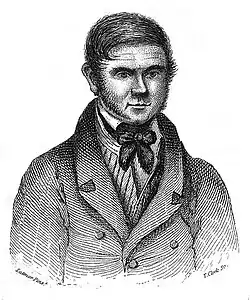 Burke
Burke
The Burke and Hare murders were a series of sixteen murders committed over a period of about ten months in 1828 in Edinburgh, Scotland. They were undertaken by William Burke and William Hare, who sold the corpses to Robert Knox for dissection at his anatomy lectures.
Edinburgh was a leading European centre of anatomical study in the early 19th century, in a time when the demand for cadavers led to a shortfall in legal supply. Scottish law required that corpses used for medical research should only come from those who had died in prison, suicide victims, or from foundlings and orphans. The shortage of corpses led to an increase in body snatching by what were known as "resurrection men". Measures to ensure graves were left undisturbed—such as the use of mortsafes—exacerbated the shortage. When a lodger in Hare's house died, he turned to his friend Burke for advice; they decided to sell the body to Knox. They received what was, for them, the generous sum of £7 10s. A little over two months later, when Hare was concerned that a lodger with a fever would deter others from staying in the house, he and Burke murdered her and sold the body to Knox. The men continued their murder spree, probably with the knowledge of their wives. Their actions were uncovered after other lodgers discovered their last victim, Margaret Docherty, and contacted the police. (Full article...) -
![Image 28 Which is your Right Hand?, illustration of an unidentified infant class drawn by Paul Renouard [fr] and published in The Graphic (1898) The first infant school in Great Britain was founded in New Lanark, Scotland, in 1816. It was followed by other philanthropic infant schools across Great Britain. Early childhood education was a new concept at the time and seen as a potential solution to social problems related to industrialisation. Numerous writers published works on the subject and developed a theory of infant teaching. This included moral education, physical exercise and an authoritative but friendly teacher. In England and Wales, infant schools served to maximise the education children could receive before they left school to start work. They were valued by parents as a form of childcare but proved less popular in Scotland. State-funded schools in England and Wales were advised in 1840 to include infant departments within their grounds. As it was integrated into the state system, infant education in England and Wales came under pressure to achieve quick academic progress in children and shifted towards rote learning. The new "kindergarten" methods of teaching young children had some limited influence on the curriculum in the late 19th century. (Full article...)](../_assets_/Blank.png) Image 28
Image 28.jpg)
Which is your Right Hand?, illustration of an unidentified infant class drawn by Paul Renouard and published in The Graphic (1898)
The first infant school in Great Britain was founded in New Lanark, Scotland, in 1816. It was followed by other philanthropic infant schools across Great Britain. Early childhood education was a new concept at the time and seen as a potential solution to social problems related to industrialisation. Numerous writers published works on the subject and developed a theory of infant teaching. This included moral education, physical exercise and an authoritative but friendly teacher.
In England and Wales, infant schools served to maximise the education children could receive before they left school to start work. They were valued by parents as a form of childcare but proved less popular in Scotland. State-funded schools in England and Wales were advised in 1840 to include infant departments within their grounds. As it was integrated into the state system, infant education in England and Wales came under pressure to achieve quick academic progress in children and shifted towards rote learning. The new "kindergarten" methods of teaching young children had some limited influence on the curriculum in the late 19th century. (Full article...) -
 Image 29
Image 29 Portrait by John de Critz, 1605
Portrait by John de Critz, 1605
Anne of Denmark (Danish: Anna; 12 December 1574 – 2 March 1619) was Queen of Scotland from her marriage to James VI and I on 20 August 1589 and Queen of England and Ireland from the union of the Scottish and English crowns on 24 March 1603 until her death in 1619.
The second daughter of King Frederick II of Denmark and Sophie of Mecklenburg-Güstrow, Anne married James at age 14. They had three children who survived infancy: Henry Frederick, Prince of Wales, who predeceased his parents; Princess Elizabeth, who became Queen of Bohemia; and James's future successor, Charles I. Anne demonstrated an independent streak and a willingness to use factional Scottish politics in her conflicts with James over the custody of Prince Henry and his treatment of her friend Beatrix Ruthven. Anne appears to have loved James at first, but the couple gradually drifted and eventually lived apart, though mutual respect and a degree of affection survived. (Full article...) -
 Image 30Walter Weir Wilson Donaldson (2 February 1907 – 24 May 1973) was a Scottish professional snooker and billiards player. He contested eight consecutive world championship finals against Fred Davis from 1947 to 1954, and won the title in 1947 and 1950. Donaldson was known for his long potting and his consistency when playing, and had an aversion to the use of side. In 2012, he was inducted posthumously into the World Professional Billiards and Snooker Association's World Snooker Hall of Fame.
Image 30Walter Weir Wilson Donaldson (2 February 1907 – 24 May 1973) was a Scottish professional snooker and billiards player. He contested eight consecutive world championship finals against Fred Davis from 1947 to 1954, and won the title in 1947 and 1950. Donaldson was known for his long potting and his consistency when playing, and had an aversion to the use of side. In 2012, he was inducted posthumously into the World Professional Billiards and Snooker Association's World Snooker Hall of Fame.
Donaldson became a professional player shortly after winning the under-16's British Junior English Billiards Championship in 1922 and won the Scottish professional billiards title six times. He first competed in the World Snooker Championship in 1933, but after a heavy defeat by Joe Davis did not enter again until 1939. After serving in the Fourth Indian Division during World War II, Donaldson entered the 1946 World Championship, where he lost to Davis in his first match. As a player that did not reach the championship final, he was eligible to enter the 1946 Albany Club Professional Snooker Tournament, which he won. Following Joe Davis's retirement from the World Championship in 1946, Donaldson practised intensively and won the 1947 Championship by defeating Fred Davis in the final. Davis won the following two championships, with Donaldson taking the next and then being runner-up to Davis for the next four years. Donaldson then retired from World Championship competition, although he continued to play in the News of the World Snooker Tournament until 1959. (Full article...) -
 Image 31
Image 31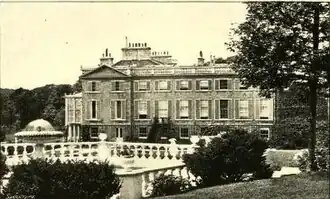
A side view of Pitfour House, c. late 19th century
The Pitfour Estate, in the Buchan area of North-East Scotland, was an ancient barony encompassing most of the extensive Longside Parish, stretching from St Fergus to New Pitsligo. It was purchased in 1700 by James Ferguson of Badifurrow, who became the first Laird of Pitfour.
The estate was substantially renovated by Ferguson and the following two generations of his family. At the height of its development in the 18th and 19th centuries the 50-square-mile (130 km2) property had several extravagant features including a two-mile racecourse, an artificial lake and an observatory. The original mansion house was extended before being rebuilt. The surrounding parklands were landscaped, major renovations were undertaken, and follies such as a small replica Temple of Theseus were constructed, in which George Ferguson, the fifth laird, was thought to keep alligators in a cold bath. (Full article...) -
 Image 32
Image 32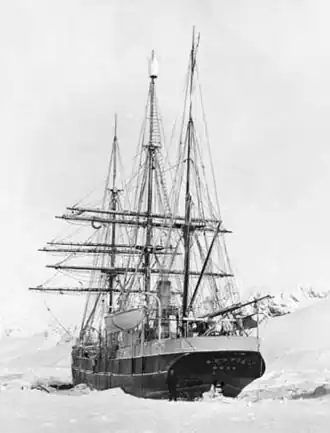
SNAE expedition ship Scotia, in the ice at Laurie Island, South Orkneys, 1903–1904
The Scottish National Antarctic Expedition (SNAE), 1902–1904, was organised and led by William Speirs Bruce, a natural scientist and former medical student from the University of Edinburgh. Although overshadowed in terms of prestige by Robert Falcon Scott's concurrent Discovery Expedition, the SNAE completed a full programme of exploration and scientific work. Its achievements included the establishment of a staffed meteorological station, the first in Antarctic territory, and the discovery of new land to the east of the Weddell Sea. Its large collection of biological and geological specimens, together with those from Bruce's earlier travels, led to the establishment of the Scottish Oceanographical Laboratory in 1906.
Bruce had spent most of the 1890s engaged on expeditions to the Antarctic and Arctic regions, and by 1899 was Britain's most experienced polar scientist. In March of that year, he applied to join the Discovery Expedition; however, his proposal to extend that expedition's field of work into the Weddell Sea quadrant, using a second ship, was dismissed as "mischievous rivalry" by Royal Geographical Society (RGS) president Sir Clements Markham. Bruce reacted by obtaining independent finance; his venture was supported and promoted by the Royal Scottish Geographical Society. (Full article...) -
 Image 33
Image 33
Gregor MacGregor (24 December 1786 – 4 December 1845) was a Scottish soldier, adventurer, and con man who attempted from 1821 to 1837 to draw British and French investors and settlers to "Poyais", a fictional Central American territory that he claimed to rule as "Cazique". Hundreds invested their savings in supposed Poyaisian government bonds and land certificates, while about 250 emigrated to MacGregor's invented country in 1822–23 to find only an untouched jungle; more than half of them died. Seen as a contributory factor to the "Panic of 1825", MacGregor's Poyais scheme has been called one of the most brazen confidence tricks in history.
From the Clan Gregor, MacGregor was an officer in the British Army from 1803 to 1810; he served in the Peninsular War. He joined the republican side in the Venezuelan War of Independence in 1812, quickly became a general and, over the next four years, operated against the Spanish on behalf of both Venezuela and its neighbour New Granada. His successes included a difficult month-long fighting retreat through northern Venezuela in 1816. He captured Amelia Island in 1817 under a mandate from revolutionary agents to conquer Florida from the Spanish, and there proclaimed a short-lived "Republic of the Floridas". He then oversaw two calamitous operations in New Granada during 1819 that each ended with his abandoning British volunteer troops under his command. (Full article...) -
 Image 34Nebula Science Fiction was the first Scottish science fiction magazine. It was published and edited, from 1952 to 1959, by Peter Hamilton, a young Scot who was able to take advantage of spare capacity at his parents' printing company, Crownpoint, to launch the magazine. Because Hamilton could only print Nebula when Crownpoint had no other work, the schedule was initially erratic. In 1955 he moved the printing to a Dublin-based firm, and the schedule became a little more regular, with a steady monthly run beginning in 1958 that lasted into the following year. Nebula's circulation was international, with only a quarter of the sales in the United Kingdom; this led to disaster when South Africa and Australia imposed import controls on foreign periodicals at the end of the 1950s. Excise duties imposed in the UK added to Hamilton's financial burdens, and he was rapidly forced to close the magazine. The last issue was dated June 1959.
Image 34Nebula Science Fiction was the first Scottish science fiction magazine. It was published and edited, from 1952 to 1959, by Peter Hamilton, a young Scot who was able to take advantage of spare capacity at his parents' printing company, Crownpoint, to launch the magazine. Because Hamilton could only print Nebula when Crownpoint had no other work, the schedule was initially erratic. In 1955 he moved the printing to a Dublin-based firm, and the schedule became a little more regular, with a steady monthly run beginning in 1958 that lasted into the following year. Nebula's circulation was international, with only a quarter of the sales in the United Kingdom; this led to disaster when South Africa and Australia imposed import controls on foreign periodicals at the end of the 1950s. Excise duties imposed in the UK added to Hamilton's financial burdens, and he was rapidly forced to close the magazine. The last issue was dated June 1959.
The magazine was popular with writers, partly because Hamilton went to great lengths to encourage new writers, and partly because he paid better rates per word than much of his competition. Initially he could not compete with the American market, but he offered a bonus for the most popular story in the issue, and was eventually able to match the leading American magazines. He published the first stories of several well-known writers, including Robert Silverberg, Brian Aldiss, and Bob Shaw. Nebula was also a fan favourite: author Ken Bulmer recalled that it became "what many fans regard as the best-loved British SF magazine". (Full article...) -
 Image 35
Image 35 Portrait by Richard Stone, 1986
Portrait by Richard Stone, 1986
Elizabeth Angela Marguerite Bowes-Lyon (4 August 1900 – 30 March 2002) was Queen of the United Kingdom and the Dominions of the British Commonwealth from 11 December 1936 to 6 February 1952 as the wife of King George VI. She was also the last Empress consort of India from 1936 until the British Raj was dissolved on 15 August 1947. After her husband died, she was officially known as Queen Elizabeth The Queen Mother to avoid confusion with her daughter Queen Elizabeth II.
Born into a family of British nobility, Elizabeth came to prominence in 1923 when she married Prince Albert, Duke of York, the second son of King George V and Queen Mary. The couple and their daughters, Elizabeth and Margaret, embodied traditional ideas of family and public service. As Duchess of York, Elizabeth undertook a variety of public engagements and became known for her consistently cheerful countenance. (Full article...) -
 Image 36
Image 36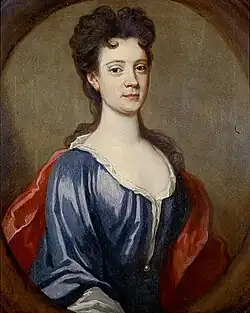 Portrait of Lady Grange by Sir John Baptiste de Medina c. 1710
Portrait of Lady Grange by Sir John Baptiste de Medina c. 1710
Rachel Chiesley (baptised 4 February 1679 – 12 May 1745), usually known as Lady Grange, was the wife of Lord Grange, a Scottish lawyer with Jacobite sympathies. After 25 years of marriage and nine children, the Granges separated acrimoniously. When Lady Grange produced letters that she claimed were evidence of his treasonable plottings against the Hanoverian government in London, her husband had her kidnapped in 1732. She was incarcerated in various remote locations on the western seaboard of Scotland, including the Monach Isles, Skye and St Kilda.
Lady Grange's father was convicted of murder and she is known to have had a violent temper; initially her absence seems to have caused little comment. News of her plight eventually reached her home town of Edinburgh and an unsuccessful rescue attempt was undertaken by her lawyer, Thomas Hope of Rankeillor. She died in captivity, after being in effect imprisoned for over 13 years. Her life has been remembered in poetry, prose and plays. (Full article...) -
 Image 37
Image 37 Portrait by Michael Dahl, 1705
Portrait by Michael Dahl, 1705
Anne (6 February 1665 – 1 August 1714) was Queen of England, Scotland, and Ireland from 8 March 1702, and Queen of Great Britain and Ireland following the ratification of the Acts of Union 1707 merging the kingdoms of Scotland and England, until her death in 1714.
Anne was born during the reign of her uncle King Charles II. Her father was Charles's younger brother and heir presumptive, James, whose suspected Roman Catholicism was unpopular in England. On Charles's instructions, Anne and her elder sister Mary were raised as Anglicans. Mary married her Dutch Protestant cousin, William III of Orange, in 1677, and Anne married the Lutheran Prince George of Denmark in 1683. On Charles's death in 1685, James succeeded to the throne, but just three years later he was deposed in the Glorious Revolution of 1688. Mary and William became joint monarchs. Although the sisters had been close, disagreements over Anne's finances, status, and choice of acquaintances arose shortly after Mary's accession and they became estranged. William and Mary had no children. After Mary's death in 1694, William reigned alone until his own death in 1702, when Anne succeeded him. (Full article...) -
![Image 38 The Little Minch, home to the blue men The blue men of the Minch, also known as storm kelpies (Scottish Gaelic: na fir ghorma Scottish Gaelic pronunciation: [nə fiɾʲ ˈɣɔɾɔmə]), are mythological creatures inhabiting the stretch of water between the northern Outer Hebrides and mainland Scotland, looking for sailors to drown and stricken boats to sink. Apart from their blue colour, the mythical creatures look much like humans, and are about the same size. They have the power to create storms, but when the weather is fine they float sleeping on or just below the surface of the water. The blue men swim with their torsos raised out of the sea, twisting and diving as porpoises do. They are able to speak, and when a group approaches a ship its chief may shout two lines of poetry to the master of the vessel and challenge him to complete the verse. If the skipper fails in that task then the blue men will attempt to capsize his ship. (Full article...)](../_assets_/Blank.png) Image 38
Image 38
The Little Minch, home to the blue men
The blue men of the Minch, also known as storm kelpies (Scottish Gaelic: na fir ghorma Scottish Gaelic pronunciation: [nə fiɾʲ ˈɣɔɾɔmə]), are mythological creatures inhabiting the stretch of water between the northern Outer Hebrides and mainland Scotland, looking for sailors to drown and stricken boats to sink.
Apart from their blue colour, the mythical creatures look much like humans, and are about the same size. They have the power to create storms, but when the weather is fine they float sleeping on or just below the surface of the water. The blue men swim with their torsos raised out of the sea, twisting and diving as porpoises do. They are able to speak, and when a group approaches a ship its chief may shout two lines of poetry to the master of the vessel and challenge him to complete the verse. If the skipper fails in that task then the blue men will attempt to capsize his ship. (Full article...) -
 Image 39In the United Kingdom, representative peers were those peers elected by the members of the Peerage of Scotland and the Peerage of Ireland to sit in the British House of Lords. Until 1999, all members of the Peerage of England held the right to sit in the House of Lords; they did not elect a limited group of representatives. All peers who were created after 1707 as Peers of Great Britain and after 1801 as Peers of the United Kingdom held the same right to sit in the House of Lords.
Image 39In the United Kingdom, representative peers were those peers elected by the members of the Peerage of Scotland and the Peerage of Ireland to sit in the British House of Lords. Until 1999, all members of the Peerage of England held the right to sit in the House of Lords; they did not elect a limited group of representatives. All peers who were created after 1707 as Peers of Great Britain and after 1801 as Peers of the United Kingdom held the same right to sit in the House of Lords.
Representative peers were introduced in 1707, when the Kingdom of England and the Kingdom of Scotland were united into the Kingdom of Great Britain. At the time there were 168 English and 154 Scottish peers. The English peers feared that the House of Lords would be swamped by the Scottish element, and consequently the election of a small number of representative peers to represent Scotland was negotiated. A similar arrangement was adopted when the Kingdom of Great Britain and the Kingdom of Ireland merged into the United Kingdom of Great Britain and Ireland in January 1801. (Full article...) -
 Image 40
Image 40 Portrait in Westminster Abbey probably depicting Edward I, installed during his reign
Portrait in Westminster Abbey probably depicting Edward I, installed during his reign
Edward I (17/18 June 1239 – 7 July 1307), also known as Edward Longshanks and the Hammer of the Scots (Latin: Malleus Scotorum), was King of England from 1272 to 1307. Concurrently, he was Lord of Ireland, and from 1254 to 1306 ruled Gascony as Duke of Aquitaine in his capacity as a vassal of the French king. Before his accession to the throne, he was commonly referred to as the Lord Edward. The eldest son of Henry III, Edward was involved from an early age in the political intrigues of his father's reign. In 1259, he briefly sided with a baronial reform movement, supporting the Provisions of Oxford. After reconciling with his father, he remained loyal throughout the subsequent armed conflict, known as the Second Barons' War. After the Battle of Lewes, Edward was held hostage by the rebellious barons, but escaped after a few months and defeated the baronial leader Simon de Montfort at the Battle of Evesham in 1265. Within two years, the rebellion was extinguished and, with England pacified, Edward left to join the Ninth Crusade to the Holy Land in 1270. He was on his way home in 1272 when he was informed of his father's death. Making a slow return, he reached England in 1274 and was crowned at Westminster Abbey.
Edward spent much of his reign reforming royal administration and common law. Through an extensive legal inquiry, he investigated the tenure of several feudal liberties. The law was reformed through a series of statutes regulating criminal and property law, but the King's attention was increasingly drawn towards military affairs. After suppressing a minor conflict in Wales in 1276–77, Edward responded to a second one in 1282–83 by conquering Wales. He then established English rule, built castles and towns in the countryside and settled them with English people. After the death of the heir to the Scottish throne, Edward was invited to arbitrate a succession dispute. He claimed feudal suzerainty over Scotland and invaded the country, and the ensuing First Scottish War of Independence continued after his death. Simultaneously, Edward found himself at war with France (a Scottish ally) after King Philip IV confiscated the Duchy of Gascony. The duchy was eventually recovered but the conflict relieved English military pressure against Scotland. By the mid-1290s, extensive military campaigns required high levels of taxation and this met with both lay and ecclesiastical opposition in England. In Ireland, he had extracted soldiers, supplies and money, leaving decay, lawlessness and a revival of the fortunes of his enemies in Gaelic territories. When the King died in 1307, he left to his son Edward II a war with Scotland and other financial and political burdens. (Full article...) -
 Image 41
Image 41
Jocelin (or Jocelyn) (died 1199) was a Scottish Cistercian monk and cleric who became the fourth Abbot of Melrose before becoming Bishop of Glasgow, Scotland. He was probably born in the 1130s, and in his teenage years became a monk of Melrose Abbey. He rose in the service of Abbot Waltheof, and by the time of the short abbacy of Waltheof's successor Abbot William, Jocelin had become prior. Then in 1170 Jocelin himself became abbot, a position he held for four years. Jocelin was responsible for promoting the cult of the emerging Saint Waltheof, and in this had the support of Enguerrand, Bishop of Glasgow.
His Glasgow connections and political profile were already well-established enough that in 1174 Jocelin succeeded Enguerrand as Glasgow's bishop. As Bishop of Glasgow, he was a royal official. In this capacity he travelled abroad on several occasions, and performed the marriage ceremony between King William the Lion and Ermengarde de Beaumont, later baptising their son, the future King Alexander II. Among other things, he has been credited by modern historians as "the founder of the burgh of Glasgow and initiator of the Glasgow fair", as well as being one of the greatest literary patrons in medieval Scotland, commissioning the Life of St Waltheof, the Life of St Kentigern and the Chronicle of Melrose. (Full article...) -
 Image 42Asahi (朝日, Morning Sun) was a pre-dreadnought battleship built for the Imperial Japanese Navy (IJN) in the late 1890s. As Japan lacked the industrial capacity to build such warships itself, the ship was designed and built in the United Kingdom. Shortly after her arrival in Japan, she became flagship of the Standing Fleet, the IJN's primary combat fleet. She participated in every major naval battle of the Russo-Japanese War of 1904–1905 and was lightly damaged during the Battle of the Yellow Sea and the Battle of Tsushima. Asahi saw no combat during World War I, although the ship participated in the Siberian Intervention in 1918.
Image 42Asahi (朝日, Morning Sun) was a pre-dreadnought battleship built for the Imperial Japanese Navy (IJN) in the late 1890s. As Japan lacked the industrial capacity to build such warships itself, the ship was designed and built in the United Kingdom. Shortly after her arrival in Japan, she became flagship of the Standing Fleet, the IJN's primary combat fleet. She participated in every major naval battle of the Russo-Japanese War of 1904–1905 and was lightly damaged during the Battle of the Yellow Sea and the Battle of Tsushima. Asahi saw no combat during World War I, although the ship participated in the Siberian Intervention in 1918. Asahi at anchor about 1906
Asahi at anchor about 1906
Reclassified as a coastal defence ship in 1921, Asahi was disarmed two years later to meet the terms of the Washington Naval Treaty, after which she served as a training and submarine depot ship. She was modified into a submarine salvage and rescue ship before being placed in reserve in 1928. Asahi was recommissioned in late 1937, after the start of the Second Sino-Japanese War, and used to transport Japanese troops. In 1938, she was converted into a repair ship and based first at Japanese-occupied Shanghai, China, and then Cam Ranh Bay, French Indochina, from late 1938 to 1941. The ship was transferred to occupied Singapore in early 1942 to repair a damaged light cruiser and ordered to return home in May. She was sunk en route by the American submarine USS Salmon, although most of her crew survived. (Full article...) -
 Image 43
Image 43.jpg) Cromwell at Dunbar, 1886, by Andrew Carrick Gow
Cromwell at Dunbar, 1886, by Andrew Carrick Gow
The Battle of Dunbar was fought between the English New Model Army, under Oliver Cromwell, and a Scottish army commanded by David Leslie on 3 September 1650 near Dunbar, Scotland. The battle resulted in a decisive victory for the English. It was the first major battle of the 1650 invasion of Scotland, which was triggered by Scotland's acceptance of Charles II as king of Britain after the beheading of his father, Charles I on 30 January 1649.
After Charles I's execution, the English Rump Parliament established a republican Commonwealth in England. When their erstwhile ally, Scotland, recognised Charles II as king of all of Britain on 1 May 1650 and began recruiting an army to support him, the English dispatched the New Model Army, under the command of Cromwell. The army crossed into Scotland on 22 July, with a force of over 16,000 men. The Scots withdrew to Edinburgh, stripping the land of provisions. Cromwell attempted to draw the Scots out into a set piece battle, but they resisted, and Cromwell was unable to break through their defensive line. At the end of August, with his army weakened through disease and lack of food, Cromwell withdrew to the port of Dunbar. The Scottish army followed and took up an unassailable position on Doon Hill, overlooking the town. On 2 September, although many of their most experienced men had been dismissed in religious purges, the Scots advanced towards Dunbar and the English took up positions outside the town. (Full article...) -
 Image 44
Image 44
One of six kelpies in the globe fountain at Shuttle Row near to Blantyre, South Lanarkshire, Scotland
A kelpie, or water kelpie (Scottish Gaelic: each-uisge), is a mythical shape-shifting spirit inhabiting lochs in Scottish folklore. Legends of these shape-shifting water-horses, under various names, spread across the British Isles, appearing in the Northern Isles, Irish, Manx, Northern English, and Welsh folklore. It is usually described as a grey or white horse-like creature, able to adopt human form. Some accounts state that the kelpie retains its hooves when appearing as a human, leading to its association with the Christian idea of Satan as alluded to by Robert Burns in his 1786 poem "Address to the Devil".
Almost every sizeable body of water in Scotland has an associated kelpie story, but the most extensively reported is that of Loch Ness. The kelpie has counterparts across the world, such as the Germanic nixie, the wihwin of Central America and the Australian bunyip. The origins of narratives about the creature are unclear, but the practical purposes of keeping children away from dangerous stretches of water and warning young women to be wary of handsome strangers has been noted in secondary literature. (Full article...) -
 Image 45
Image 45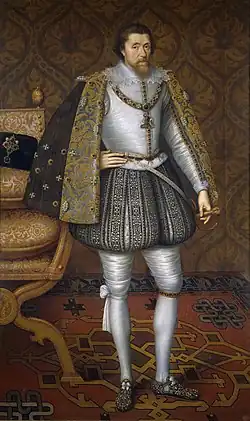 Portrait attributed to John de Critz, c. 1605
Portrait attributed to John de Critz, c. 1605
James VI and I (James Charles Stuart; 19 June 1566 – 27 March 1625) was King of Scotland as James VI from 24 July 1567 and King of England and Ireland as James I from the union of the Scottish and English crowns on 24 March 1603 until his death in 1625. Though he long attempted to get both countries to adopt a closer political union, the kingdoms of Scotland and England remained sovereign states, with their own parliaments, judiciaries, and laws, ruled by James in personal union.
James was the son of Mary, Queen of Scots, and a great-great-grandson of Henry VII, King of England and Lord of Ireland, and thus a potential successor to all three thrones. He acceded to the Scottish throne at the age of thirteen months, after his mother was forced to abdicate in his favour. Although his mother was a Catholic, James was brought up as a Protestant. Four regents governed during his minority, which ended officially in 1578, though he did not gain full control of his government until 1583. In 1589, he married Anne of Denmark. Three of their children survived to adulthood: Henry Frederick, Elizabeth, and Charles. In 1603, James succeeded his cousin Elizabeth I, the last Tudor monarch of England and Ireland, who died childless. He continued to reign in all three kingdoms for 22 years, a period known as the Jacobean era, until his death in 1625. After the Union of the Crowns, he based himself in England (the largest of the three realms) from 1603, returning to Scotland only once, in 1617, and styled himself "King of Great Britain and Ireland". He advocated for a single parliament for England and Scotland. In his reign, the Plantation of Ulster and English colonisation of the Americas began. (Full article...) -
![Image 46 A 19th-century reproduction of an impression of Donnchadh's seal, surviving from a Melrose charter, depicting [according to antiquarian Henry Laing] a "winged dragon"; the inscription reads SIGILLUM DUNCANI FILII GILLEBER.. ("The seal of Donnchadh son of Gille-Brighde") Donnchadh (Scottish Gaelic pronunciation: [ˈt̪ɔn̪ˠɔxəɣ]; Latin: Duncanus; English: Duncan) was a Gall-Gaidhil prince and Scottish magnate in what is now south-western Scotland, whose career stretched from the last quarter of the 12th century until his death in 1250. His father, Gille-Brighde of Galloway, and his uncle, Uhtred of Galloway, were the two rival sons of Fergus, Prince or Lord of Galloway. As a result of Gille-Brighde's conflict with Uhtred and the Scottish monarch William the Lion, Donnchadh became a hostage of King Henry II of England. He probably remained in England for almost a decade before returning north on the death of his father. Although denied succession to all the lands of Galloway, he was granted lordship over Carrick in the north. Allied to John de Courcy, Donnchadh fought battles in Ireland and acquired land there that he subsequently lost. A patron of religious houses, particularly Melrose Abbey and North Berwick priory nunnery, he attempted to establish a monastery in his own territory, at Crossraguel. He married the daughter of Alan fitz Walter, a leading member of the family later known as the House of Stewart—future monarchs of Scotland and England. Donnchadh was the first mormaer or earl of Carrick, a region he ruled for more than six decades, making him one of the longest serving magnates in medieval Scotland. His descendants include the Bruce and Stewart Kings of Scotland, and probably the Campbell Dukes of Argyll. (Full article...)](../_assets_/Blank.png) Image 46
Image 46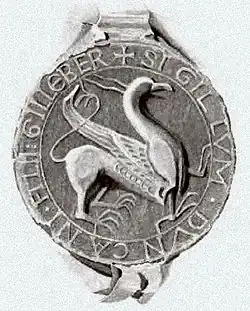 A 19th-century reproduction of an impression of Donnchadh's seal, surviving from a Melrose charter, depicting [according to antiquarian Henry Laing] a "winged dragon"; the inscription reads SIGILLUM DUNCANI FILII GILLEBER.. ("The seal of Donnchadh son of Gille-Brighde")
A 19th-century reproduction of an impression of Donnchadh's seal, surviving from a Melrose charter, depicting [according to antiquarian Henry Laing] a "winged dragon"; the inscription reads SIGILLUM DUNCANI FILII GILLEBER.. ("The seal of Donnchadh son of Gille-Brighde")
Donnchadh (Scottish Gaelic pronunciation: [ˈt̪ɔn̪ˠɔxəɣ]; Latin: Duncanus; English: Duncan) was a Gall-Gaidhil prince and Scottish magnate in what is now south-western Scotland, whose career stretched from the last quarter of the 12th century until his death in 1250. His father, Gille-Brighde of Galloway, and his uncle, Uhtred of Galloway, were the two rival sons of Fergus, Prince or Lord of Galloway. As a result of Gille-Brighde's conflict with Uhtred and the Scottish monarch William the Lion, Donnchadh became a hostage of King Henry II of England. He probably remained in England for almost a decade before returning north on the death of his father. Although denied succession to all the lands of Galloway, he was granted lordship over Carrick in the north.
Allied to John de Courcy, Donnchadh fought battles in Ireland and acquired land there that he subsequently lost. A patron of religious houses, particularly Melrose Abbey and North Berwick priory nunnery, he attempted to establish a monastery in his own territory, at Crossraguel. He married the daughter of Alan fitz Walter, a leading member of the family later known as the House of Stewart—future monarchs of Scotland and England. Donnchadh was the first mormaer or earl of Carrick, a region he ruled for more than six decades, making him one of the longest serving magnates in medieval Scotland. His descendants include the Bruce and Stewart Kings of Scotland, and probably the Campbell Dukes of Argyll. (Full article...) -
 Image 47
Image 47
The Isle of Skye, or simply Skye, is the largest and northernmost of the major islands in the Inner Hebrides of Scotland. The island's peninsulas radiate from a mountainous hub dominated by the Cuillin, the rocky slopes of which provide some of the most dramatic mountain scenery in the country. Although Sgitheanach has been suggested to describe a winged shape, no definitive agreement exists as to the name's origin.
The island has been occupied since the Mesolithic period, and over its history has been occupied at various times by Celtic tribes including the Picts and the Gaels, Scandinavian Vikings, and most notably the powerful integrated Norse-Gaels clans of
MacLeod and MacDonald. The island was considered to be under Norwegian suzerainty until the 1266 Treaty of Perth, which transferred control over to Scotland. (Full article...) -
 Image 48
Image 48
The Anglo-Scottish war (1650–1652), also known as the Third Civil War, was the final conflict in the Wars of the Three Kingdoms, a series of armed conflicts and political machinations between shifting alliances of religious and political factions in England, Scotland and Ireland.
The 1650 English invasion of Scotland was a pre-emptive military incursion by the English Commonwealth's New Model Army, intended to allay the risk of Charles II invading England with a Scottish army. The First and Second English Civil Wars, in which English Royalists, loyal to Charles I, fought Parliamentarians for control of the country, took place between 1642 and 1648. When the Royalists were defeated for the second time the English government, exasperated by the duplicity of Charles I during negotiations, set up a High Court of Justice which found the King guilty of treason and executed him on 30 January 1649. At the time, England and Scotland were separate independent kingdoms, joined politically through a personal union; Charles I was, separately, both the King of Scotland, and the King of England. The Scots had fought in support of the English Parliamentarians in the First English Civil War, but sent an army in support of Charles I into England during the Second English Civil War. The Parliament of Scotland, which had not been consulted before the execution, declared his son, Charles II, King of Britain. (Full article...) -
 Image 49
Image 49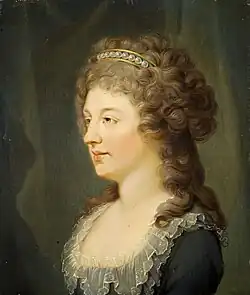 Portrait by Hugh Douglas Hamilton, Scottish National Portrait Gallery
Portrait by Hugh Douglas Hamilton, Scottish National Portrait Gallery
Charlotte Stuart, styled Duchess of Albany (29 October 1753 – 17 November 1789) was the illegitimate daughter of the Jacobite pretender Charles Edward Stuart ("Bonnie Prince Charlie" or the "Young Pretender") and his only child to survive infancy.
Charlotte's mother was Clementina Walkinshaw, who was mistress to Charles Edward from 1752 until 1760. After years of abuse, Clementina left him, taking Charlotte with her. Charlotte spent most of her life in French convents, estranged from a father who refused to make any provision for her. Unable to marry, she herself became a mistress with illegitimate children, taking Ferdinand de Rohan, Archbishop of Bordeaux, as her lover. (Full article...) -
 Image 50Whisky Galore! is a 1949 British comedy film produced by Ealing Studios, starring Basil Radford, Bruce Seton, Joan Greenwood and Gordon Jackson. It was the directorial debut of Alexander Mackendrick; the screenplay was by Compton Mackenzie, an adaptation of his 1947 novel Whisky Galore, and Angus MacPhail. The story—based on a true event, the running aground of the SS Politician—concerns a shipwreck off a fictional Scottish island, the inhabitants of which have run out of whisky because of wartime rationing. The islanders find out the ship is carrying 50,000 cases of whisky, some of which they salvage, against the opposition of the local Customs and Excise men.
Image 50Whisky Galore! is a 1949 British comedy film produced by Ealing Studios, starring Basil Radford, Bruce Seton, Joan Greenwood and Gordon Jackson. It was the directorial debut of Alexander Mackendrick; the screenplay was by Compton Mackenzie, an adaptation of his 1947 novel Whisky Galore, and Angus MacPhail. The story—based on a true event, the running aground of the SS Politician—concerns a shipwreck off a fictional Scottish island, the inhabitants of which have run out of whisky because of wartime rationing. The islanders find out the ship is carrying 50,000 cases of whisky, some of which they salvage, against the opposition of the local Customs and Excise men.
It was filmed on the island of Barra; the weather was so poor that the production over-ran its 10-week schedule by five weeks, and the film went £20,000 over budget. Michael Balcon, the head of the studio, was unimpressed by the initial cut of the film, and one of Ealing's directors, Charles Crichton, added footage and re-edited the film before its release. Like other Ealing comedies, Whisky Galore! explores the actions of a small insular group facing and overcoming a more powerful opponent. An unspoken sense of community runs through the film, and the story reflects a time when the British Empire was weakening. (Full article...)
Selection of good articles
![]()
-
 Image 1
Image 1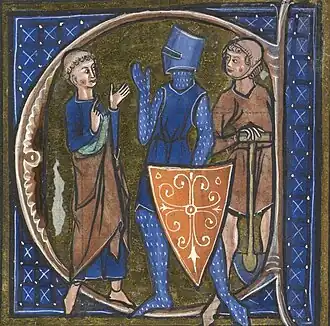
A French illustration of representatives of the three estates, a cleric, a knight and a worker, which were adopted in the fourteenth century to describe the membership of the Parliament of Scotland
Social structure in what is now Scotland is obscure in the early part of the Middle Ages, for which there are few documentary sources. Kinship groups probably provided the primary system of organisation and society was probably divided between a small aristocracy, whose rationale was based around warfare, a wider group of freemen, who had the right to bear arms and were represented in law codes, above a relatively large body of slaves, who may have lived beside and become clients of their owners.
From the twelfth century there are sources that allow the stratification in society to be seen in detail, with layers including the king and a small elite of mormaers above lesser ranks of freemen and what was probably a large group of serfs, particularly in central Scotland. In this period the feudalism introduced under David I meant that baronial lordships began to overlay this system, the English terms earl and thane became widespread. Below the noble ranks were husbandmen with small farms and growing numbers of cottars and gresemen (grazing tenants) with more modest landholdings. The combination of agnatic kinship and feudal obligations has been seen as creating the system of clans in the Highlands in this era. Scottish society adopted theories of the three estates to describe its society and English terminology to differentiate ranks. Serfdom disappeared from the records in the fourteenth century and new social groups of labourers, craftsmen and merchants, became important in the developing burghs. This led to increasing social tensions in urban society, but, in contrast to England and France, there was a lack of major unrest in Scottish rural society, where there was relatively little economic change. (Full article...) -
 Image 2
Image 2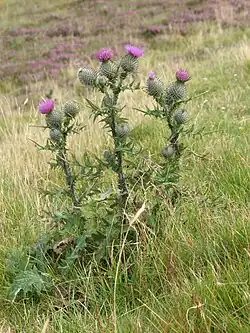
Spear Thistle
The flora of Scotland is an assemblage of native plant species including over 1,600 vascular plants, more than 1,500 lichens and nearly 1,000 bryophytes. The total number of vascular species is low by world standards but lichens and bryophytes are abundant and the latter form a population of global importance. Various populations of rare fern exist, although the impact of 19th-century collectors threatened the existence of several species. The flora is generally typical of the north-west European part of the Palearctic realm and prominent features of the Scottish flora include boreal Caledonian forest (much reduced from its natural extent), heather moorland and coastal machair. In addition to the native species of vascular plants there are numerous non-native introductions, now believed to make up some 43% of the species in the country.
There are a variety of important tree species and specimens; in particular, the Fortingall Yew may be the oldest tree in Europe. The Arran Whitebeams, Shetland Mouse-ear and Scottish Primrose are endemic flowering plants and there are a variety of endemic mosses and lichens. Conservation of the natural environment is well developed and various organisations play an important role in the stewardship of the country's flora. Numerous references to the country's flora appear in folklore, song and poetry. (Full article...) -
 Image 3
Image 3
Elections to South Lanarkshire Council took place on 5 May 2022 on the same day as the 31 other Scottish local government elections. As with other Scottish council elections, it was held using single transferable vote (STV) – a form of proportional representation – in which multiple candidates are elected in each ward and voters rank candidates in order of preference.
For the second consecutive election, the Scottish National Party were returned with the most seats at 27 but remained shy of an overall majority. Labour made small gains to again finish second with an increased number of members with 24 – up two from 2017 – while the Conservatives lost half their number to return seven members. The Liberal Democrats and independents both made two gains to return three and two members respectively while the Greens won their first ever seat in South Lanarkshire. (Full article...) -
 Image 4
Image 4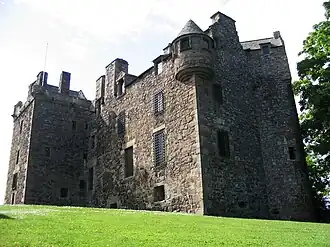 The front of Elcho Castle
The front of Elcho Castle
Elcho Castle (/ˈɛl.xoʊ/) is located close to the south bank of the River Tay approximately four miles south-east of Perth, Scotland, in the region of Perth and Kinross. It was maintained by Clan Wemyss from its construction around 1560 until it was put into the care of the Secretary of State for Scotland in the early 20th century, though was not occupied for the entire time. In around 1830 it was re-roofed and a nearby cottage constructed. The castle has been a scheduled monument since 1920 on the grounds of being "a particularly fine example of a Medieval tower-house", and the cottage became a listed building in 1971 in recognition of its national importance. The castle is unusual in that it has both en suite guest accommodation like a mansion, but also a large number of gun loops. (Full article...) -
 Image 5
Image 5
The intimate portrait of his second wife Margaret Lindsay by Allan Ramsay, 1758
Scottish art in the eighteenth century is the body of visual art made in Scotland, by Scots, or about Scottish subjects, in the eighteenth century. This period saw development of professionalisation, with art academies were established in Edinburgh and Glasgow. Art was increasingly influenced by Neoclassicism, the Enlightenment and towards the end of the century by Romanticism, with Italy becoming a major centre of Scottish art.
The origins of the tradition of Scottish landscape painting are in the capriccios of Italian and Dutch landscapes undertaken by James Norie and his sons. These were further developed by Jacob More, who added a romantic sensibility to the Scottish landscape. Alexander Nasmyth helped found the Scottish landscape tradition and was highly influential as a teacher in Edinburgh on the subsequent generation of artists. John Knox linked it with the Romantic, historical myth-making novels of Walter Scott and was one of the first artists to take an interest in the urban landscape of Glasgow. Aberdeen-born John Alexander and William Mossman were the leading portrait artists of the first half of the century. Allan Ramsay emerged as the leading portrait painter of the mid-century and to the royal family, noted for his intimate representations. Towards the end of the century Henry Raeburn emerged as the leading portraitist and one of the first artists to spend the majority of their career in Scotland, extending his range to leading figures of the Enlightenment and most famous for his depiction of the Skating Minister. (Full article...) -
 Image 6Meantime is a 2022 crime fiction novel by the Scottish comedian Frankie Boyle. The story follows drug addict Felix McAveety's unfocused investigation into his friend Marina's death. It is set in Glasgow, Scotland, shortly after the 2014 independence referendum. Felix is aided by the crime fiction writer Jane, the left-wing activist Amy and his depressed neighbour Donnie. They meet Chong, who seems to believe reality is simulated, and find signs that British Intelligence are involved in Marina's death.
Image 6Meantime is a 2022 crime fiction novel by the Scottish comedian Frankie Boyle. The story follows drug addict Felix McAveety's unfocused investigation into his friend Marina's death. It is set in Glasgow, Scotland, shortly after the 2014 independence referendum. Felix is aided by the crime fiction writer Jane, the left-wing activist Amy and his depressed neighbour Donnie. They meet Chong, who seems to believe reality is simulated, and find signs that British Intelligence are involved in Marina's death.
Though he had written non-fiction before, Meantime was Boyle's first novel; he wrote parts of the novel in hotels after stand-up performances and while wandering his hometown Glasgow. The book was published by Baskerville, a new crime fiction imprint of John Murray, on 21 July 2022. It was nominated for Bloody Scotland's Debut of the Year award. (Full article...) -
 Image 7
Image 7
The West Highland White Terrier (commonly shortened to Westie) is a breed of dog from Scotland with a distinctive white harsh coat and somewhat soft white undercoat. It is a medium-sized terrier, though with longer legs than other Scottish terriers. It has a white double coat of fur which fills out the dog's face, giving it a rounded appearance.
The Westie is intelligent, quick to learn, and can be good with children, but does not always tolerate rough handling. It is an energetic, boisterous, and social breed with a high prey drive, having been bred to hunt small rodents at places such as farms, and needs regular exercise of around one hour per day. The modern breed is descended from a number of pre-20th century breeding programmes of white terriers in Scotland. Edward Donald Malcolm, 16th Laird of Poltalloch, is credited with the creation of the modern breed from his Poltalloch Terrier but did not want to be known as such. (Full article...) -
 Image 8
Image 8
Elections to Aberdeenshire Council took place on Thursday 5 May 2022 on the same day as the 31 other Scottish local government elections. As with other Scottish council elections, it was held using single transferable vote (STV) – a form of proportional representation – in which multiple candidates are elected in each ward and voters rank candidates in order of preference.
For the second consecutive election, the Conservatives were returned as the largest party on the council, however they fell short of an overall majority despite gaining three seats on a reduced vote share. The Scottish National Party (SNP) remained the second largest party with 21 seats on an increased vote share from 2017. The Liberal Democrats also recorded no change in councillors, returning 14, on a slightly higher vote share than in 2017. Labour and the Greens lost their only seats on the council and the number of independent councillors returned decreased by one despite the number of votes being cast for these candidates increasing slightly. (Full article...) -
 Image 9Alexander Patrick Greysteil Hore-Ruthven, 2nd Earl of Gowrie, PC, FRSL (26 November 1939 – 24 September 2021), usually known as Grey Gowrie or Lord Gowrie, was an Irish-born British hereditary peer, politician, and businessman. Lord Gowrie was also the hereditary Clan Chief of Clan Ruthven in Scotland. He was educated at Eton and Oxford, and held posts in academia for a period, in the US and London, including time working with poet Robert Lowell and at Harvard University.
Image 9Alexander Patrick Greysteil Hore-Ruthven, 2nd Earl of Gowrie, PC, FRSL (26 November 1939 – 24 September 2021), usually known as Grey Gowrie or Lord Gowrie, was an Irish-born British hereditary peer, politician, and businessman. Lord Gowrie was also the hereditary Clan Chief of Clan Ruthven in Scotland. He was educated at Eton and Oxford, and held posts in academia for a period, in the US and London, including time working with poet Robert Lowell and at Harvard University.
Gowrie was a Conservative Party politician for some years, including a period in the British Cabinet. He held ministerial posts under Margaret Thatcher, in the areas of employment and Northern Ireland, and was Minister of State for the Arts, as well as Chancellor of the Duchy of Lancaster, with responsibility for Civil Service reform. Offered a promotion to full Secretary of State, with responsibility for education across the UK, he turned it down. Previously an arts dealer, he moved to Sotheby's for a reputed salary of around £150,000, chairing parts of the art auction business. He later chaired the Arts Council of England (1994–1998). (Full article...) -
 Image 10
Image 10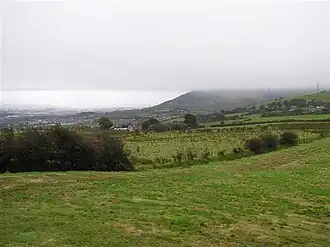 Squire's Hill, north Belfast, the area of the murders
Squire's Hill, north Belfast, the area of the murders
The 1971 Scottish soldiers killings took place in Northern Ireland during The Troubles. On 10 March 1971, the Provisional Irish Republican Army (IRA) shot dead three off-duty British soldiers of the 1st Battalion, Royal Highland Fusiliers. The soldiers were from Scotland and two were teenage brothers. They were lured from a pub in Belfast where they had been drinking, driven to a remote location and shot by the roadside. Three British soldiers had been killed before this, but all had been killed during rioting.
The deaths led to public mourning and protests against the IRA. Pressure to act spurred a political crisis for the Northern Ireland Government, which led to the resignation of James Chichester-Clark as Prime Minister of Northern Ireland. The British Army raised the minimum age needed to serve in Northern Ireland to 18 in response to this incident. In 2010, a memorial was dedicated to the three soldiers near the site of their deaths. (Full article...) -
 Image 11
Image 11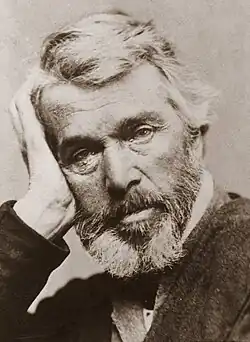 Portrait c. 1865
Portrait c. 1865
Thomas Carlyle (4 December 1795 – 5 February 1881) was a Scottish essayist, historian and philosopher. Known as the "sage of Chelsea", his writings strongly influenced the intellectual and artistic culture of the Victorian era.
Carlyle was born in Ecclefechan, a village in Dumfriesshire, Scotland. He attended the University of Edinburgh, where he excelled in mathematics and invented the Carlyle circle. After finishing the arts course he prepared to become a minister in the Burgher Church while working as a schoolmaster. He quit these and several other endeavours before settling on literature, writing for the Edinburgh Encyclopædia and working as a translator. He initially gained prominence in English-language literary circles for his extensive writing on German Romantic literature and philosophy. These themes were explored in his first major work, a semi-autobiographical philosophical novel entitled Sartor Resartus (1833–34). (Full article...) -
![Image 12 Shops on Fenwick Road Giffnock (/ˈɡɪfnək/; Scots: Giffnock; Scottish Gaelic: Giofnag, pronounced [ˈkʲifnak]) is a town and the administrative centre of East Renfrewshire in the Central Lowlands of Scotland. It lies 3.7 miles (6.0 km) east of Barrhead, 5.6 miles (9.0 km) east-southeast of Paisley and 5.3 miles (8.5 km) northwest of East Kilbride, at the southwest of the Greater Glasgow conurbation. (Full article...)](../_assets_/Blank.png) Image 12
Image 12 Shops on Fenwick Road
Shops on Fenwick Road
Giffnock (/ˈɡɪfnək/; Scots: Giffnock; Scottish Gaelic: Giofnag, pronounced [ˈkʲifnak]) is a town and the administrative centre of East Renfrewshire in the Central Lowlands of Scotland.
It lies 3.7 miles (6.0 km) east of Barrhead, 5.6 miles (9.0 km) east-southeast of Paisley and 5.3 miles (8.5 km) northwest of East Kilbride, at the southwest of the Greater Glasgow conurbation. (Full article...) -
 Image 13The 1999 Scottish Challenge Cup final, also known as the Bell's Challenge Cup final for sponsorship reasons, was a football match between Inverness Caledonian Thistle and Alloa Athletic on 21 November 1999 at Excelsior Stadium in Airdrie. It was the ninth final of the Scottish Challenge Cup since it was first organised in 1990 to celebrate the centenary of the Scottish Football League.
Image 13The 1999 Scottish Challenge Cup final, also known as the Bell's Challenge Cup final for sponsorship reasons, was a football match between Inverness Caledonian Thistle and Alloa Athletic on 21 November 1999 at Excelsior Stadium in Airdrie. It was the ninth final of the Scottish Challenge Cup since it was first organised in 1990 to celebrate the centenary of the Scottish Football League.
Both teams progressed through four elimination rounds to reach the final. The match was Alloa Athletic's first national cup final in its 121-year history whilst it was Inverness Caledonian Thistle's first since the club was founded five years beforehand in 1994. The tournament was contested by clubs below the Scottish Premier League; Inverness Caledonian Thistle from the First Division and Alloa Athletic from the Second Division. (Full article...) -
 Image 14
Image 14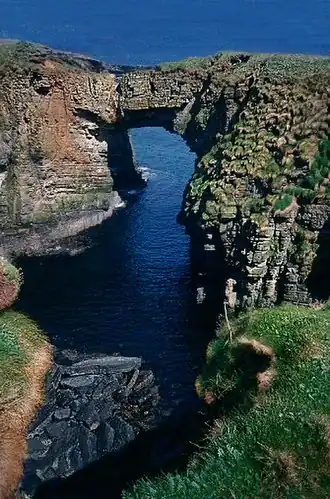
The seas of Orkney are calm during the periods of Sea Mither's reign.
Sea Mither, or Mither of the Sea, is a mythical being of Orcadian folklore that lives in the sea during summer, when she confines the demonic nuckelavee to the ocean depths. Each spring she battles with her arch-enemy Teran, another spirit of Orcadian legend capable of causing severe winter storms, to gain control of the seas and the weather. Eventually Sea Mither overcomes Teran and sends him to the depths of the ocean, but the effort of keeping him confined there along with her other benevolent labours during the summer exhaust her, until in the autumn Teran takes advantage of her weakness to wrest control from her once again.
Stories of the Sea Mither and Teran are among Orkney's oldest legends, perhaps invented to explain the vagaries of weather and other naturally occurring events. In Shetland, fishermen petition Sea Mither to afford them protection from the Devil. (Full article...) -
 Image 15
Image 15
Shetland (until 1975 spelled Zetland), also called the Shetland Islands, is an archipelago in Scotland lying between Orkney, the Faroe Islands, and Norway, marking the northernmost region of the United Kingdom. The islands lie about 50 miles (80 kilometres) to the northeast of Orkney, 110 mi (170 km) from mainland Scotland and 140 mi (220 km) west of Norway. They form part of the border between the Atlantic Ocean to the west and the North Sea to the east. The island's area is 1,467 km2 (566 sq mi) and the population totalled 22,986 in 2022. The islands comprise the Shetland constituency of the Scottish Parliament. The islands' administrative centre, largest settlement and only burgh is Lerwick, which has been the capital of Shetland since 1708, before which time the capital was Scalloway. Due to its location it is accessible only by ferry or flight with an airport located in Sumburgh as well as a port and emergency airstrip in Lerwick.
The archipelago has an oceanic climate, complex geology, rugged coastline, and many low, rolling hills.
The largest island, known as "the Mainland", has an area of 373 sq mi (967 km2), and is the fifth-largest island in the British Isles. It is one of 16 inhabited islands in Shetland. (Full article...) -
 Image 16
Image 16.jpg) Aerial view of Doune Castle and the Castle keeper's cottage
Aerial view of Doune Castle and the Castle keeper's cottage
Doune Castle is a medieval stronghold near the village of Doune, in the Stirling council area of central Scotland and the historic county of Perthshire. The castle is sited on a wooded bend where the Ardoch Burn flows into the River Teith. It lies 8 miles (13 kilometres) northwest of Stirling, where the Teith flows into the River Forth. Upstream, 8 miles (13 kilometres) further northwest, the town of Callander lies at the edge of the Trossachs, on the fringe of the Scottish Highlands.
Recent research has shown that Doune Castle was originally built in the thirteenth century, then probably damaged in the Scottish Wars of Independence, before being rebuilt in its present form in the late 14th century by Robert Stewart, Duke of Albany (c. 1340–1420), the son of Robert II of Scotland, and Regent of Scotland from 1388 until his death. Duke Robert's stronghold has survived relatively unchanged and complete, and the whole castle was traditionally thought of as the result of a single period of construction at this time. The castle passed to the crown in 1425, when Albany's son was executed, and was used as a royal hunting lodge and dower house. In the later 16th century, Doune became the property of the Earls of Moray. The castle saw military action during the Wars of the Three Kingdoms and Glencairn's rising in the mid-17th century, and during the Jacobite risings of the late 17th century and 18th century. By 1800 the castle was ruined, but restoration works were carried out in the 1880s, prior to its passing into state care in the 20th century. It is now maintained by Historic Environment Scotland. (Full article...) -
 Image 17Thomas Francis Birney (born August 11, 1956) is a Scottish-born American former professional football placekicker who played two seasons in the National Football League (NFL) for the Green Bay Packers. He played college football for the Michigan State Spartans and was also a member of the New England Patriots, Cincinnati Bengals and Pittsburgh Steelers in the NFL, and the Michigan Panthers of the United States Football League. (Full article...)
Image 17Thomas Francis Birney (born August 11, 1956) is a Scottish-born American former professional football placekicker who played two seasons in the National Football League (NFL) for the Green Bay Packers. He played college football for the Michigan State Spartans and was also a member of the New England Patriots, Cincinnati Bengals and Pittsburgh Steelers in the NFL, and the Michigan Panthers of the United States Football League. (Full article...) -
 Image 18
Image 18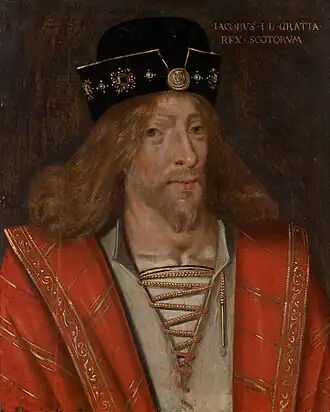 16th century portrait of James
16th century portrait of James
James I (late July 1394 – 21 February 1437) was King of Scots from 1406 until his assassination in 1437. The youngest of three sons, he was born in Dunfermline Abbey to King Robert III and Annabella Drummond. His eldest brother David, Duke of Rothesay, died under suspicious circumstances while detained by his uncle, Robert, Duke of Albany. James's other brother, Robert, died young. Concerns for James's safety deepened in the winter of 1405–1406 prompting plans to send him to France. In February 1406, James took refuge in the castle of the Bass Rock in the Firth of Forth after his escort was attacked by supporters of Archibald, 4th Earl of Douglas. He remained there until mid-March when he boarded a vessel bound for France. On 22 March, an English vessel captured the ship and delivered James to Henry IV of England. The ailing Robert III died on 4 April and the 11-year-old James, now the uncrowned King of Scotland, would remain in captivity for eighteen years.
James was educated well during his imprisonment in England, where he was often kept in the Tower of London, Windsor Castle, and other English castles. He was generally well-treated and developed respect for English forms of governance. James joined Henry V of England in his military campaigns in France between 1420 and 1421. His cousin, Murdoch Stewart (Albany's son), an English prisoner since 1402, was traded for Henry Percy, 2nd Earl of Northumberland, in 1416. However, Albany refused to negotiate James's release. James married Joan Beaufort, daughter of the Earl of Somerset, in February 1424, shortly before his release in April. His return to Scottish affairs was not altogether popular due to his service to Henry V in France, sometimes against Scottish forces. Noble families faced increased taxes to fund the ransom payments, and to provide family hostages as security. James, who excelled in sports, literature, and music, aimed to impose law and order on his subjects but sometimes he applied such order selectively. (Full article...) -
 Image 19The recorded history of Scotland begins with the arrival of the Roman Empire in the 1st century, when the province of Britannia reached as far north as the Antonine Wall. North of this was Caledonia, inhabited by the Picti, whose uprisings forced Rome's legions back to Hadrian's Wall. As Rome finally withdrew from Britain, a Gaelic tribe from Ireland called the Scoti began colonising Western Scotland and Wales. Before Roman times, prehistoric Scotland entered the Neolithic Era about 4000 BC, the Bronze Age about 2000 BC, and the Iron Age around 700 BC.
Image 19The recorded history of Scotland begins with the arrival of the Roman Empire in the 1st century, when the province of Britannia reached as far north as the Antonine Wall. North of this was Caledonia, inhabited by the Picti, whose uprisings forced Rome's legions back to Hadrian's Wall. As Rome finally withdrew from Britain, a Gaelic tribe from Ireland called the Scoti began colonising Western Scotland and Wales. Before Roman times, prehistoric Scotland entered the Neolithic Era about 4000 BC, the Bronze Age about 2000 BC, and the Iron Age around 700 BC.
The Gaelic kingdom of Dál Riata was founded on the west coast of Scotland in the 6th century. In the following century, Irish missionaries introduced the previously pagan Picts to Celtic Christianity. Following England's Gregorian mission, the Pictish king Nechtan chose to abolish most Celtic practices in favour of the Roman rite, restricting Gaelic influence on his kingdom and avoiding war with Anglian Northumbria. Towards the end of the 8th century, the Viking invasions began, forcing the Picts and Gaels to cease their historic hostility to each other and to unite in the 9th century, forming the Kingdom of Scotland. (Full article...) -
 Image 20
Image 20
Hampden Park (/ˈhɑːmdən/ HAHM-dən; Scottish Gaelic: Pàirc Hampden) is a football stadium in the Mount Florida area of Glasgow, Scotland, which is the national stadium of football in Scotland and home of the Scotland national football team, as well as Queen’s Park FC, the original owners. Hampden Park is owned by the Scottish Football Association (SFA), and regularly hosts the latter stages of the Scottish Cup and Scottish League Cup. The largest stadium by capacity when opened in 1903, an accolade the stadium held until 1950, Hampden Park is the 11th-largest football stadium in the United Kingdom, and the second-largest football stadium in Scotland. The stadium retains all attendance records recorded in European football.
A UEFA category four stadium, Hampden Park has hosted six European finals including the 1960 European Cup final between Real Madrid and Eintracht Frankfurt which, with a crowd of 127,621 in attendance, is the highest ever recorded attendance for a European Cup final. The stadium houses the offices of the Scottish Football Association (SFA) and Scottish Professional Football League (SPFL) and has hosted three European Cup/Champions League finals, two Cup Winners' Cup finals and a UEFA Cup final. It has hosted other sporting events including the 2012 Olympic Games and the 2014 Commonwealth Games (also hosting the 2014 Commonwealth Games closing ceremony). Scotland was one of the eleven host countries of the pan–European Euro 2020 tournament with the stadium hosting the round of 16 matches and will host matches of the upcoming Euro 2028, of which Scotland is again one of the host countries. (Full article...) -
 Image 21
Image 21.jpg) Official portrait, c. 2008
Official portrait, c. 2008
James Gordon Brown (born 20 February 1951) is a British politician who served as Prime Minister of the United Kingdom and Leader of the Labour Party from 2007 to 2010. Previously, he was Chancellor of the Exchequer from 1997 to 2007 under Tony Blair. Brown was Member of Parliament (MP) for Dunfermline East from 1983 to 2005 and for Kirkcaldy and Cowdenbeath from 2005 to 2015. He has served as United Nations Special Envoy for Global Education since 2012, and he was appointed as World Health Organization Ambassador for Global Health Financing in 2021.
A doctoral graduate, Brown studied history at the University of Edinburgh. He spent his early career as a lecturer at a further education college and as a television journalist. Brown was elected to the House of Commons at the 1983 general election as the MP for Dunfermline East. He was appointed to Neil Kinnock's shadow cabinet in 1989 and was named Shadow Chancellor of the Exchequer by John Smith in 1992. Following Labour's victory in the 1997 general election, Brown was appointed as Chancellor, becoming the longest-serving in modern history. Brown's time as chancellor was marked by major reform of Britain's monetary and fiscal policy architecture, transferring interest rate setting to the Bank of England, extending the powers of the Treasury to cover much domestic policy, and transferring banking supervision to the Financial Services Authority. Brown presided over the longest period of economic growth in British history. He outlined five economic tests, which resisted the UK adopting the euro. Controversial moves included the abolition of advance corporation tax (ACT) relief in his first budget, the sale of UK gold reserves from 1999 to 2002, and the removal in his final budget of the 10% starting rate of income tax that he had introduced in the 1999 budget. (Full article...) -
 Image 22
Image 22
James VI in 1580, aged 14. A major patron of poetry as well as a poet and commentator, his accession to the English throne in 1603 had profound effects on the patronage of Scottish literature and the Scots language
Literature in early modern Scotland is literature written in Scotland or by Scottish writers between the Renaissance in the early sixteenth century and the beginnings of the Enlightenment and Industrial Revolution in mid-eighteenth century. By the beginning of this era Gaelic had been in geographical decline for three centuries and had begun to be a second-class language, confined to the Highlands and Islands, but the traditions of Bard poetry in the Classical Gaelic literary language continued to survive. Middle Scots became the language of both the nobility and the majority population. The establishment of a printing press in 1507 made it easier to disseminate Scottish literature and was probably aimed at bolstering Scottish national identity.
James IV's creation of a Renaissance court included the patronage of poets, or makars, who were mainly clerics. These included Gavin Douglas, whose Eneados (1513) was the first complete translation of a major classical text in an Anglian language. James V was also a major patron of poets. George Buchanan founded a tradition of neo-Latin poetry. In the reign of Mary, Queen of Scots and the minority of her son James VI, cultural pursuits were limited by the lack of a royal court and by political turmoil. The Kirk discouraged poetry that was not devotional in nature but secular poetry survived. In the 1580s and 1590s James VI promoted literature in Scots. He became patron and member of a loose circle of Scottish court poets and musicians, later called the Castalian Band. David Lyndsay's The Thrie Estaitis (1540) is the only complete play to survive from before the Reformation. Buchanan was major influence on Continental theatre, but his impact in Scotland was limited by his choice of Latin as a medium. There were isolated Scottish plays, but the system of professional companies of players and theatres that developed in England in this period was absent in Scotland. (Full article...) -
![Image 23 Dualling work in 2021 between Luncarty and Pass of Birnam, the second section of the scheme. The A9 dualling project is an ongoing infrastructure project in Scotland to upgrade the A9 between Perth and Inverness from a single carriageway to a dual carriageway. A dual carriageway allows drivers to overtake safely, as they do not have to meet oncoming traffic; and the crash barriers on the central reservation greatly reduce the frequency of head-on collisions. As most of the A9 is currently a single carriageway, drivers may have to overtake heavy goods vehicles (HGVs) and other slow-moving vehicles as they are limited to 50 miles per hour (80 km/h), 10 miles per hour (16 km/h) lower than the speed limit for cars and motorcycles. The A9 has been dubbed Scotland's most dangerous road. In 2022, there were 17 fatalities, its highest level in 20 years before falling to four in 2023. The project was announced in November 2011 with construction starting in September 2015. This started with a 5-mile (8 km) section between Kincraig and Dalraddy (near Aviemore) followed by the 6-mile (10 km) Luncarty to Pass of Birnam in February 2019. This project was originally due to finish in 2025, but has since been delayed to 2035 for various reasons. As of 2025[update], two out of eleven sections have been completed, totalling 11 miles (17 km), leaving 77 miles (124 km) to be upgraded. Work started on the third section between Tomatin and Moy in October 2024 and is due to be finished in 2028. (Full article...)](../_assets_/Blank.png) Image 23
Image 23 Dualling work in 2021 between Luncarty and Pass of Birnam, the second section of the scheme.
Dualling work in 2021 between Luncarty and Pass of Birnam, the second section of the scheme.
The A9 dualling project is an ongoing infrastructure project in Scotland to upgrade the A9 between Perth and Inverness from a single carriageway to a dual carriageway. A dual carriageway allows drivers to overtake safely, as they do not have to meet oncoming traffic; and the crash barriers on the central reservation greatly reduce the frequency of head-on collisions. As most of the A9 is currently a single carriageway, drivers may have to overtake heavy goods vehicles (HGVs) and other slow-moving vehicles as they are limited to 50 miles per hour (80 km/h), 10 miles per hour (16 km/h) lower than the speed limit for cars and motorcycles. The A9 has been dubbed Scotland's most dangerous road. In 2022, there were 17 fatalities, its highest level in 20 years before falling to four in 2023.
The project was announced in November 2011 with construction starting in September 2015. This started with a 5-mile (8 km) section between Kincraig and Dalraddy (near Aviemore) followed by the 6-mile (10 km) Luncarty to Pass of Birnam in February 2019. This project was originally due to finish in 2025, but has since been delayed to 2035 for various reasons. As of 2025, two out of eleven sections have been completed, totalling 11 miles (17 km), leaving 77 miles (124 km) to be upgraded. Work started on the third section between Tomatin and Moy in October 2024 and is due to be finished in 2028. (Full article...) -
 Image 24
Image 24 Drawing of the aftermath of the Tradeston Flour Mills explosion in the Illustrated London News on 20 July 1872
Drawing of the aftermath of the Tradeston Flour Mills explosion in the Illustrated London News on 20 July 1872
On 9 July 1872 the Tradeston Flour Mills, in Glasgow, Scotland, exploded. Eighteen people died, and at least sixteen were injured. An investigation suggested that the explosion was caused by the grain feed to a pair of millstones stopping, causing them to rub against each other, resulting in a spark or fire igniting the grain dust in the air. That fire was then drawn by a fan into an "exhaust box" designed to collect grain dust, which then ignited, causing a second explosion which destroyed the building. At the time, there were general concerns about similar incidents worldwide, so the incident and investigation were widely reported across the world. (Full article...) -
 Image 25Rear-Admiral James Walker CB CvTE (1764 – 13 July 1831) was an officer of the Royal Navy. He served during the American War of Independence, and the French Revolutionary and Napoleonic Wars.
Image 25Rear-Admiral James Walker CB CvTE (1764 – 13 July 1831) was an officer of the Royal Navy. He served during the American War of Independence, and the French Revolutionary and Napoleonic Wars.
Walker spent his early years in the navy at first in British waters during the invasion scares of 1779, and then in North American waters where he saw action at most of the decisive naval battles of the war, particularly at the Chesapeake, St. Kitts and the Saintes. He reached the rank of lieutenant before the end of hostilities and spent the interwar years travelling on the continent. Returning to service with the outbreak of war with the French, he again participated in many of the key naval actions of the period, with his service at the Glorious First of June securing his promotion to his own commands. His career was almost ended with an accusation of disobeying orders, which led to his dismissal from the navy, but he was reinstated in time to develop a plan to subdue the mutinies at Spithead and the Nore. He commanded a ship at the Battle of Camperdown, and another at the Battle of Copenhagen, earning Nelson's praise for his actions. (Full article...)
Lists of featured content
| This is a list of recognized content, updated weekly by JL-Bot (talk · contribs) (typically on Saturdays). There is no need to edit the list yourself. If an article is missing from the list, make sure it is tagged (e.g. {{WikiProject Scotland}}) or categorized correctly and wait for the next update. See WP:RECOG for configuration options. |
Featured articles
- Áedán mac Gabráin
- Anglo-Scottish war (1650–1652)
- Anne, Queen of Great Britain
- Anne of Denmark
- HMS Argus (I49)
- Japanese battleship Asahi
- Sieges of Berwick (1355 and 1356)
- Battle of Blenheim
- Blue men of the Minch
- William Bruce (architect)
- William Speirs Bruce
- Burke and Hare murders
- Burnt Candlemas
- Constantine II of Scotland
- Cullen House
- David I of Scotland
- Walter Donaldson (snooker player)
- Donnchadh, Earl of Carrick
- Alec Douglas-Home
- Battle of Dunbar (1650)
- Edward I of England
- Elgin Cathedral
- Queen Elizabeth The Queen Mother
- Fauna of Scotland
- From the Doctor to My Son Thomas
- Rachel Chiesley, Lady Grange
- Margaret Macpherson Grant
- Great North of Scotland Railway
- Bryan Gunn
- Battle of Halidon Hill
- HMS Hood
- History of infant schools in Great Britain
- Battle of Inverkeithing
- James II of England
- James VI and I
- Jocelin of Glasgow
- Kelpie
- John Knox
- Elizabeth Maitland, Duchess of Lauderdale
- War of the League of Cambrai
- Gregor MacGregor
- Mary, Queen of Scots
- Murray Maxwell
- William McGregor (football)
- Nebula Science Fiction
- Neilston
- Nuckelavee
- Order of the Thistle
- Pitfour estate
- HMS Ramillies (07)
- Renewable energy in Scotland
- Representative peer
- Rockstar North
- HMS Royal Oak (08)
- Scotland in the High Middle Ages
- Scotland national football team
- Scottish National Antarctic Expedition
- Shapinsay
- Isle of Skye
- Charlotte Stuart, Duchess of Albany
- HMS Vanguard (23)
- Second War of Scottish Independence
- John Wark
- Westminster Assembly
- Whisky Galore! (1949 film)
- John Michael Wright
Former featured articles
Good articles
- A82 road
- 1873–74 Scottish Cup
- 2001 Scottish Masters
- 2002 Scottish Masters
- 2014 Scottish Labour leadership election
- 2022 Aberdeen City Council election
- 2022 Aberdeenshire Council election
- 2022 Angus Council election
- 2022 Argyll and Bute Council election
- 2022 City of Edinburgh Council election
- 2022 Clackmannanshire Council election
- 2022 Comhairle nan Eilean Siar election
- 2022 Dumfries and Galloway Council election
- 2022 East Ayrshire Council election
- 2022 Fife Council election
- 2022 Glasgow City Council election
- 2022 Highland Council election
- 2022 North Ayrshire Council election
- 2022 North Lanarkshire Council election
- 2022 Orkney Islands Council election
- 2022 Shetland Islands Council election
- 2022 South Ayrshire Council election
- 2022 South Lanarkshire Council election
- 2024 World Athletics Indoor Championships – Women's 4 × 400 metres relay
- 2024 World Athletics Indoor Championships – Women's 400 metres
- A9 dualling project
- Aberdeen F.C.
- Aberdeen F.C.–Rangers F.C. rivalry
- Aberdour Castle
- William Adam (architect)
- William Aitken (architect)
- Arbroath
- Architecture of Scotland
- Architecture in early modern Scotland
- Architecture in modern Scotland
- Architecture of Scotland in the Industrial Revolution
- Architecture of Scotland in the Middle Ages
- Architecture of Scotland in the Roman era
- Architecture of Scotland in the prehistoric era
- Art in Medieval Scotland
- Art in early modern Scotland
- Art in modern Scotland
- Allison Balfour
- James Balfour (died 1845)
- John Barrowman
- Battle of Barry
- Jim Baxter
- Ian Begg (architect)
- Ben Nevis
- Lewis Benson (boxer)
- Guy Berryman
- The Bhoys from Seville
- Billy Boys
- Tom Birney
- The Black Island
- HMS Bonaventure (31)
- Boobrie
- Bill Bowman (Scottish politician)
- Gordon Brown
- Brownie (folklore)
- Alexander Buchan (artist)
- Calendar (New Style) Act 1750
- James Campbell (British Army officer, died 1745)
- Camus Cross
- Peter Capaldi
- Thomas Carlyle
- Castles in Scotland
- Celtic F.C. in European football
- Celtic Park
- Erik Chisholm
- Church architecture in Scotland
- Winston Churchill
- Clan Maclachlan
- Clydesdale horse
- HMS Conqueror (1911)
- The Cookery Book of Lady Clark of Tillypronie
- Coxton Tower
- Craigiehall
- Lord Ninian Crichton-Stuart
- Cruachan Power Station
- Cullen Old Church
- Cultybraggan Camp
- 1966 European Cup Winners' Cup final
- The Daily Mash
- Dandie Dinmont Terrier
- Ruth Davidson
- James Davis (escaped convict)
- Dead Pony
- Demographic history of Scotland
- Paul Dickov
- Mary Docherty
- Donkey Punch (novel)
- Doune Castle
- Dowhill Castle
- Dubh Artach
- Andrew Dudley
- Duncraig Castle
- Dunnottar Castle
- Dunrobin Castle
- Dunstaffnage Castle
- East Kirkton Quarry
- East Stirlingshire F.C.
- Easter Road
- Economy of Scotland in the Middle Ages
- Economy of Scotland in the early modern period
- Edinburgh Castle
- University of Edinburgh
- Edinburgh Zoo
- Education in Medieval Scotland
- Education in early modern Scotland
- Edzell Castle
- Eenoolooapik
- Eidyn
- Elcho Castle
- English invasion of Scotland (1400)
- Eriskay Pony
- Estate houses in Scotland
- 1884 FA Cup final
- Edward G. Faile
- Fairy Flag
- Falkirk Wheel
- Family in early modern Scotland
- James Ferguson, Lord Pitfour
- James Ferguson (Scottish politician)
- Finnieston Crane
- Flora of Scotland
- Sir Ewan Forbes, 11th Baronet
- Forglen House
- Forth Bridge
- Forth Valley Royal Hospital
- Dario Franchitti
- Château Gaillard
- Ryan Gauld
- Geography of Scotland in the Middle Ages
- Geography of Scotland in the early modern era
- Geology of Scotland
- Giffnock
- Gilli (Hebridean earl)
- Glass Swords
- The Glenlivet distillery
- Glenrothes
- Glorious Revolution in Scotland
- Government in early modern Scotland
- Government in medieval Scotland
- Isobel Gowdie
- Grey Gowrie
- John Gregorson Campbell
- Hampden Park
- Hibernian F.C.
- Highland cattle
- Highlands and Islands Alliance
- Lists of mountains and hills in the British Isles
- Hillforts in Scotland
- History of Scotland
- History of agriculture in Scotland
- Mary Hogarth
- Housing in Scotland
- How the Scots Invented the Modern World
- Leslie Hunter
- HMS Hurst Castle
- Ibrox Stadium
- 1902 Ibrox disaster
- Illieston House
- Inchdrewer Castle
- Inner Hebrides
- James Innes (British Army officer, died 1759)
- Charles Irving (surgeon)
- Islands of the Clyde
- Islay
- James I of Scotland
- Bert Jansch
- Jarlshof
- Jocky Wilson Cup
- Kelvin Scottish
- Battle of Kinghorn
- Kirkandrews, Dumfries and Galloway
- Kirkcaldy
- Kirkcudbright Tolbooth
- Labour Party of Scotland
- Johann Lamont
- Landscape painting in Scotland
- Billy Liddell
- Literature in early modern Scotland
- Kim Little
- Loch Arkaig treasure
- Loch Henry
- Lochleven Castle
- RAF Lossiemouth
- Donald MacKay (architect)
- Murder of Alesha MacPhail
- Clan MacAulay
- RAF Machrihanish
- Doris Mackinnon
- Sorley MacLean
- Richard Madden
- SS Manasoo
- Marmalade
- James Clerk Maxwell
- Maybole Castle
- James McAvoy
- Stuart McCall
- Angus McDonald (Virginia militiaman)
- McEwan's
- Ewan McGregor
- John George McTavish
- Johnny McNichol
- Meantime (novel)
- Colin Mitchell
- Steven Moffat
- Michelle Mone, Baroness Mone
- Monifieth
- William Montgomerie
- Simone Murphy
- James Murray, Lord Philiphaugh
- Music in early modern Scotland
- John Mylne (died 1667)
- The National (Scotland)
- Robert Alexander Neil
- John Ogilby
- One Kiss
- Orkney
- Outer Hebrides
- Paisley witches
- Papa Stour
- Partick Thistle F.C.
- Portrait painting in Scotland
- Potion (song)
- Prehistoric art in Scotland
- Raasay
- Ragnall ua Ímair
- Alex Raisbeck
- Lynne Ramsay
- Rangers F.C. signing policy
- Renaissance in Scotland
- Richard Rennison
- Rhapsody (climb)
- Rockstar Dundee
- Romanticism in Scotland
- Andrew Ross (rugby union, born 1879)
- Royal Banner of Scotland
- Rusco Tower
- St Margaret's Church, Aberlour
- St Peter's Roman Catholic Church, Buckie
- St Rufus Church
- Scandinavian Scotland
- Schiehallion experiment
- Flag of Scotland
- Scotland during the Roman Empire
- Scotland in the Late Middle Ages
- Scotland in the Middle Ages
- Scotland in the early modern period
- Scotland in the modern era
- Scotland national football team manager
- Scotland under the Commonwealth
- Scottish art
- 1999 Scottish Challenge Cup final
- 2002 Scottish Challenge Cup final
- 2007 Scottish Challenge Cup final
- Scottish Challenge Cup
- 2012 Scottish Cup final
- 2019 Scottish Open (snooker)
- 1971 Scottish soldiers' killings
- Scottish Terrier
- Scottish art in the eighteenth century
- Scottish art in the nineteenth century
- Scottish invasion of England (1648)
- Scottish religion in the eighteenth century
- Scottish religion in the seventeenth century
- Scottish society in the Middle Ages
- Scottish society in the early modern era
- Scuttling of the German fleet at Scapa Flow
- Sea Mither
- Bill Shankly
- Shetland
- Shieling
- Ian Smith (rugby union, born 1903)
- Jimmy Speirs
- Staffa
- Jessie Stephen
- Andrew Still (actor)
- Still Wakes the Deep
- Alexander Stoddart
- Stoor worm
- John Struthers (anatomist)
- Charles Edward Stuart
- Sundrum Castle
- Swim School
- Philipp Tanzer
- Tay Whale
- D'Arcy Wentworth Thompson
- Thurso
- Tibbers Castle
- Titan Clydebank
- Torf-Einarr
- Tradeston Flour Mills explosion
- Trident (UK nuclear programme)
- USS Tucker (DD-374)
- German submarine U-27 (1936)
- Urien
- Urquhart Castle
- James Walker (Australian politician)
- James Walker (Royal Navy officer)
- William Middleton Wallace
- Warfare in Medieval Scotland
- Warfare in early modern Scotland
- Water bull
- West Highland White Terrier
- Robert White (Virginia physician)
- Krysty Wilson-Cairns
- Witch trials in early modern Scotland
- Andrew Wodrow
- Women in early modern Scotland
Former good articles
- Isle of Arran
- Alexander Bain (inventor)
- Eilley Bowers
- Billy Bremner
- British Isles
- British people
- William Buchanan (locomotive designer)
- Canadian Gaelic
- Andrew Carnegie
- Carnoustie
- Coatbridge
- Catherine Cranston
- Arthur Conan Doyle
- Dundee United F.C.
- Steve Evans (footballer, born 1962)
- Evanton
- Forth Road Bridge
- Glasgow
- Glasgow, Paisley, Kilmarnock and Ayr Railway
- University of Glasgow
- Frank Hadden
- Halloween
- David Hume
- Jordanhill railway station
- Deborah Kerr
- Lothian Buses
- Gillian McKeith
- Mingulay
- Andy Murray
- Picts
- Scotland
- Scots language
- Still Game
- Alec Sutherland
- Tay Bridge
- Treasure Island
- William Morrison (chemist)
Featured lists
- List of islands of Scotland
- List of Celtic F.C. managers
- List of Scottish Football League clubs
- List of Scotland international footballers
- List of Scotland ODI cricketers
- List of Scotland national football team hat-tricks
- List of Scottish football champions
- List of Scottish football clubs in the FA Cup
- PFA Scotland Players' Player of the Year
- SFWA Footballer of the Year
- Scotland national football team results (1872–1914)
- Timeline of prehistoric Scotland
- Timeline of Scottish football
Featured pictures
-
 13-06-07 RaR Biffy Clyro Simon Neil 02
13-06-07 RaR Biffy Clyro Simon Neil 02 -
 Aerial View of Edinburgh, by Alfred Buckham, from about 1920
Aerial View of Edinburgh, by Alfred Buckham, from about 1920 -
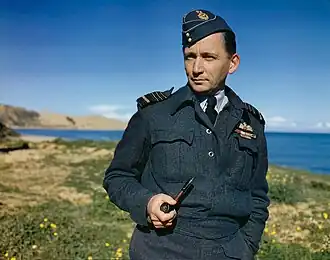 Air Chief Marshal Sir Arthur Tedder on the Italian coast, 17 December 1943
Air Chief Marshal Sir Arthur Tedder on the Italian coast, 17 December 1943 -
 Alexander Gardner by James Gardner - 1863
Alexander Gardner by James Gardner - 1863 -
 Arthur-James-Balfour-1st-Earl-of-Balfour
Arthur-James-Balfour-1st-Earl-of-Balfour -
.jpg) CAMPBELL, George W-Treasury (BEP engraved portrait)
CAMPBELL, George W-Treasury (BEP engraved portrait) -
 Charles Robert Leslie - Sir Walter Scott - Ravenswood and Lucy at the Mermaiden's Well - Bride of Lammermoor
Charles Robert Leslie - Sir Walter Scott - Ravenswood and Lucy at the Mermaiden's Well - Bride of Lammermoor -
_2.jpg) Common seal (Phoca vitulina) 2
Common seal (Phoca vitulina) 2 -
 Dalziel Brothers - Sir Walter Scott - The Talisman - Sir Kenneth before the King
Dalziel Brothers - Sir Walter Scott - The Talisman - Sir Kenneth before the King -
 Daniel Craig McCallum by The Brady National Photographic Art Gallery
Daniel Craig McCallum by The Brady National Photographic Art Gallery -
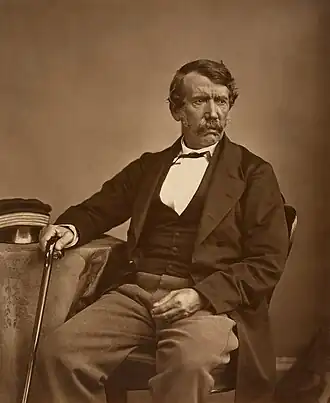 David Livingstone by Thomas Annan
David Livingstone by Thomas Annan -
.jpg) Dunrobin Castle -Sutherland -Scotland-26May2008 (2)
Dunrobin Castle -Sutherland -Scotland-26May2008 (2) -
 Edinburgh Castle from Grass Market
Edinburgh Castle from Grass Market -
 Eilean Donan Castle, Scotland - Jan 2011
Eilean Donan Castle, Scotland - Jan 2011 -
Falkirk Wheel Timelapse, Scotland - Diliff
-
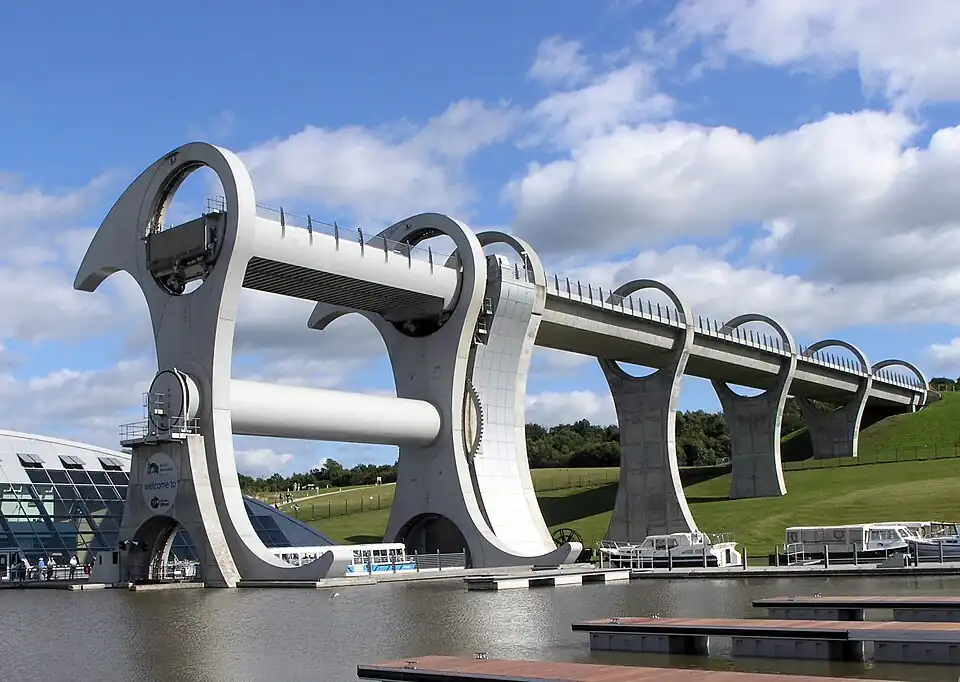 FalkirkWheelSide 2004 SeanMcClean
FalkirkWheelSide 2004 SeanMcClean -
 Gavin Hamilton - Coriolanus Act V, Scene III edit2
Gavin Hamilton - Coriolanus Act V, Scene III edit2 -
 Jaguar at Edinburgh Zoo
Jaguar at Edinburgh Zoo -
 JamesIEngland
JamesIEngland -
 Jeremiah Gurney - Photograph of Euphrosyne Parepa-Rosa
Jeremiah Gurney - Photograph of Euphrosyne Parepa-Rosa -
 Loch Torridon, Scotland
Loch Torridon, Scotland -
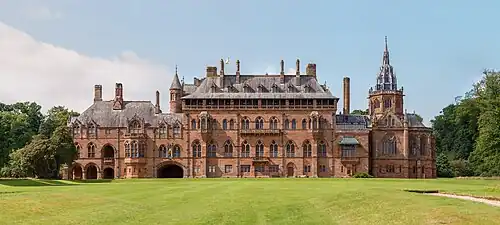 Mount Stuart House 2018-08-25
Mount Stuart House 2018-08-25 -
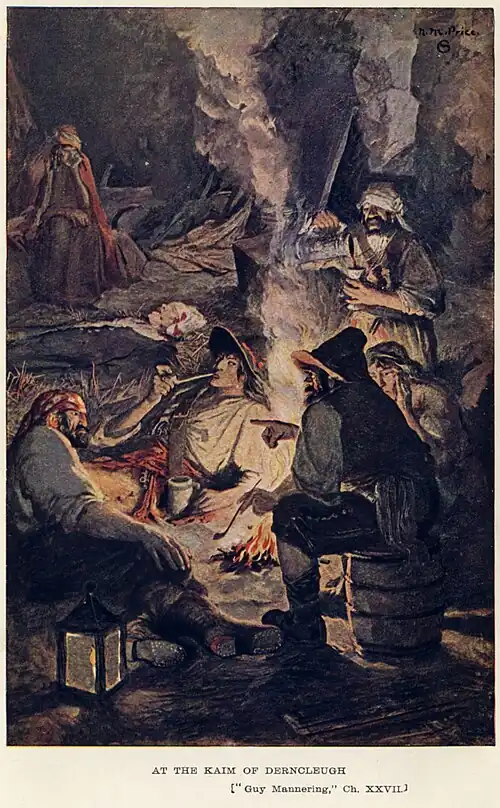 N. M. Price - Sir Walter Scott - Guy Mannering - At the Kaim of Derncleugh
N. M. Price - Sir Walter Scott - Guy Mannering - At the Kaim of Derncleugh -
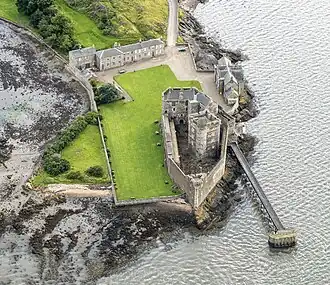 NEWScotland-2016-Aerial-Blackness Castle 01
NEWScotland-2016-Aerial-Blackness Castle 01 -
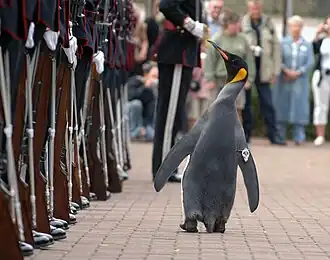 Nils Olav inspects the Kings Guard of Norway after being bestowed with a knighthood at Edinburgh Zoo in Scotland
Nils Olav inspects the Kings Guard of Norway after being bestowed with a knighthood at Edinburgh Zoo in Scotland -
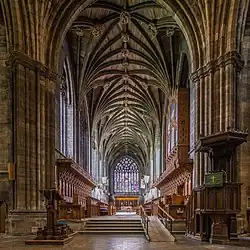 Paisley Abbey Interior East
Paisley Abbey Interior East -
 Paisley Abbey from the south east
Paisley Abbey from the south east -
 Prince James Francis Edward Stuart by Alexis Simon Belle
Prince James Francis Edward Stuart by Alexis Simon Belle -
 Robert William Thomson - Illustrated London News March 29 1873
Robert William Thomson - Illustrated London News March 29 1873 -
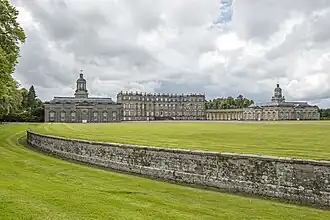 Scotland-2016-West Lothian-Hopetoun House 02
Scotland-2016-West Lothian-Hopetoun House 02 -
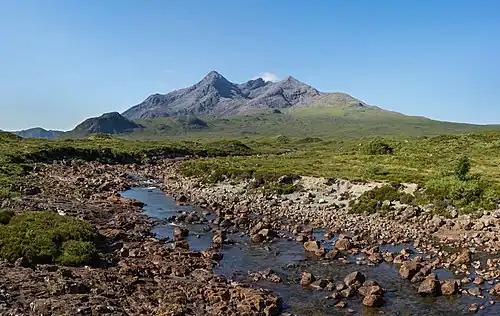 Sgùrr nan Gillean from Sligachan, Isle of Skye, Scotland - Diliff
Sgùrr nan Gillean from Sligachan, Isle of Skye, Scotland - Diliff -
_-_Google_Art_Project.jpg) Sir Anthony Van Dyck - Charles I (1600-49) - Google Art Project
Sir Anthony Van Dyck - Charles I (1600-49) - Google Art Project -
 Sir William Thomson, Baron Kelvin by T. & R. Annan & Sons
Sir William Thomson, Baron Kelvin by T. & R. Annan & Sons -
 St Matthew's Church - Paisley - Interior - 5
St Matthew's Church - Paisley - Interior - 5 -
 Synthetic Production of Penicillin TR1468
Synthetic Production of Penicillin TR1468 -
 The Air Ministry, 1939-1945. CH10270 – Edit 1
The Air Ministry, 1939-1945. CH10270 – Edit 1 -
 The Monarch of the Glen, Edwin Landseer, 1851
The Monarch of the Glen, Edwin Landseer, 1851 -
_Skating_on_Duddingston_Loch.jpg) The Skating Minister
The Skating Minister -
 Thomas Keene in Macbeth 1884 Wikipedia crop
Thomas Keene in Macbeth 1884 Wikipedia crop -
View of loch lomond
-
 Wemyss Bay railway station concourse 2018-08-25 2
Wemyss Bay railway station concourse 2018-08-25 2 -
 William Hatherell - Robert Louis Stephenson - The Bottle Imp 1
William Hatherell - Robert Louis Stephenson - The Bottle Imp 1 -
 William Hatherell - Robert Louis Stephenson - The Bottle Imp 2
William Hatherell - Robert Louis Stephenson - The Bottle Imp 2 -
 William John Macquorn Rankine by Thomas Annan
William John Macquorn Rankine by Thomas Annan
Get involved
| ||||||||||||||||||||||||||||||
For editor resources and to collaborate with other editors on improving Wikipedia's Scotland-related articles, see WikiProject Scotland.
To get involved in helping to improve Wikipedia's Scotland related content, please consider doing some of the following tasks or joining one or more of the associated Wikiprojects:
- Visit the Scottish Wikipedians' notice board and help to write new Scotland-related articles, and expand and improve existing ones.
- Visit Wikipedia:WikiProject Scotland/Assessment, and help out by assessing unrated Scottish articles.
- Add the Project Banner to Scottish articles around Wikipedia.
- Participate in WikiProject Scotland's Peer Review, including responding to PR requests and nominating Scottish articles.
- Help nominate and select new content for the Scotland portal.
Do you have a question about The Scotland Portal that you can't find the answer to?
Post a question on the Talk Page or consider asking it at the Wikipedia reference desk.
Related portals
Wikipedia in other relevant languages
Associated Wikimedia
The following Wikimedia Foundation sister projects provide more on this subject:
-
Commons
Free media repository -
Wikibooks
Free textbooks and manuals -
Wikidata
Free knowledge base -
Wikinews
Free-content news -
Wikiquote
Collection of quotations -
Wikisource
Free-content library -
Wikispecies
Directory of species -
Wikiversity
Free learning tools -
Wikivoyage
Free travel guide -
Wiktionary
Dictionary and thesaurus
Discover Wikipedia using portals
-
 List of all portals
List of all portals -

-

-

-

-

-

-

-

-

-
 Random portal
Random portal -
 WikiProject Portals
WikiProject Portals
This article is issued from Wikipedia. The text is available under Creative Commons Attribution-Share Alike 4.0 unless otherwise noted. Additional terms may apply for the media files.
.png)

